Explore Jobs
- Jobs Near Me
- Remote Jobs
- Full Time Jobs
- Part Time Jobs
- Entry Level Jobs
- Work From Home Jobs
Find Specific Jobs
- $15 Per Hour Jobs
- $20 Per Hour Jobs
- Hiring Immediately Jobs
- High School Jobs
- H1b Visa Jobs
Explore Careers
- Business And Financial
- Architecture And Engineering
- Computer And Mathematical
Explore Professions
- What They Do
- Certifications
- Demographics
Best Companies
- Health Care
- Fortune 500
Explore Companies
- CEO And Executies
- Resume Builder
- Career Advice
- Explore Majors
- Questions And Answers
- Interview Questions

A Complete Guide To Situational Analysis (With Examples)
- What Is Figurative Language?
- What Are Rhetorical Strategies?
- What Is a Subject Matter Expert and What Do They Do?
- What Is A Differentiation Strategy
- What Is Job Order Costing
- What Is Situational Analysis
- Plan Of Action
- Report Format
- Law Of Diminishing Marginal Returns
- Administrative Duties
- Giving A Presentation
- Organizational Behavior Management
- Deductive Reasoning
- Reflective Listening
Summary. Situational Analysis is used to assess the internal and external factors of a business. It is used to help determine a business’ strengths, weaknesses, potential new customers, and any issues that may be there. The three popular methos of situational analysis are SWOT analysis, 5C’s analysis, and Porters Five Forces.
Successful businesses don’t just wing it and hope for the best. They proactively evaluate the landscape of their industry and the internal assets they possess. To do this, executives, team leaders, project managers, and others in positions of strategic leadership perform situational analyses.
A situational analysis allows for a company to take stock of its internal strengths and deficiencies, while also identifying the broader trends happening among competition and customers. It’s an invaluable step zero that smart teams run before making any grand plans.
We’ll cover three of the most popular methods for running a situational analysis, break down the benefits of each, and provide tips for performing one.
Key Takeaways:
Situational analysis assesses the internal and external factors of a business to clarify its advantages and disadvantages.
A situational analysis is particularly useful before launching a new project or marketing campaign.
There are many ways to perform a situational analysis such as, the SWOT analysis, the 5 C’s Analysis, and Porter’s Five Forces.
A useful situational analysis should be practical, easy to understand, provides equal attention to internal and external factors, and sets goals for your business.
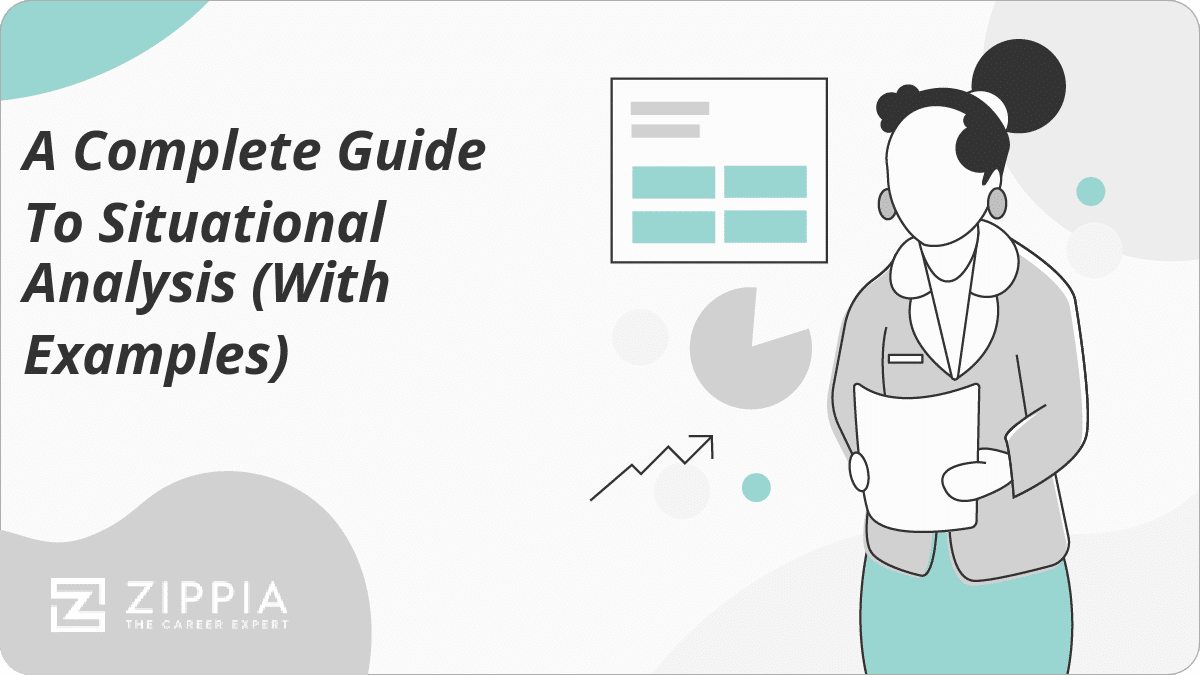
What Is a Situational Analysis?
Factors to consider in situation analysis, why is a situational analysis important, methods of situational analysis, what is swot analysis, what is the 5c’s analysis, what is a porter five forces analysis, how to complete a situational analysis, qualities of useful situational analysis results, challenges of situational analysis, situational analysis faq.
- Sign Up For More Advice and Jobs
A situational analysis is a method used to assess the internal and external factors of a business. It identifies both the advantages a business enjoys and the challenges that it is likely to face.
The ultimate goal of situational analysis is to determine a business’ strengths, weaknesses, potential new customers, and lingering issues that contribute to the company’s general standing. Multiple different methods of analysis are used to complete this evaluation, and they’re often used in conjunction with one another.
Usually, situational analysis is started before launching a new project or embracing new marketing strategies. A situational analysis incorporates a few factors for consideration. These include:
Competition. Determine what steps you want your company to take by comparing the advantages you have over your competition and vice versa.
Product. Understand your product, whether it is a good or service. If you have multiple products, make sure to analyze them independently and assess how they relate to one another.
Distribution. Analyze how your product moves through the supply chain from beginning to end.
Customers. Know who your current customers are and who you want your prospective customers to be.
Market Environment. The environment of your market includes your industry and localized economy, as well as your relationship to suppliers and customers.
The purpose of conducting a situation analysis is to get a better understanding of the factors that will affect your company’s success. The results of a situational analysis give the business insight into how to move forward.
A situational analysis is important because there’s no way to fully grasp the scope of mitigating factors that impact the outcome of a company without implementing it in some form. It’s running an organization blindly.
A situational analysis describes the work environment for what it does well, where it needs improvement, and where the likeliest avenues of growth are.
Companies use several different methods to outline their overall performance and decide on what actions they should take next. A comprehensive situational analysis uses at least two of these methods to evaluate a company’s status.
Popular methods of situational analysis include:
SWOT analysis
5C’s analysis
Porter five forces
A SWOT analysis is a method of situational analysis that relies on taking stock of your Strengths, Weaknesses, Opportunities, and Theats. It;s a popular method of situational analysis. There are four main areas that this SWOT analysis looks into:
Strengths . Evaluating a company’s strengths asks you to determine what they do well. These can be positive aspects of their product, customer relations, or any other feature that acts as a strength.
Weaknesses. While many organizations are vocal and aware of their strengths, they may be less willing to face their weaknesses . However, understanding a company’s weaknesses and what areas these reside in is crucial to improvement.
Opportunities. Gathering a company’s opportunity pool is often a lot of brainstorming . Opportunities are places that the business expands to further its success. This could be in the form of catering to a new customer base or entering an emerging market.
Threats. More than any other piece of the SWOT analysis, the threats portion asks a business to think about external factors. These are outside entities or aspects that hurt a business and can lead to failure down the line.
These broad aspects are the qualities that determine a business’ current standing, future options, and potential problems.
The 5C’s analysis serves a similar function to the SWOT, but it’s used as a framework for marketing, rather than determining a company’s overall health. Understanding the 5C’s establishes marketing strategies that put a business ahead of its competition.
The 5C’s are:
Company. Even though the 5C method of analysis deals with marketing and competition, the first step is to look inward at your own company. Consider your business’ abilities, products, current marketing, and financials. Take stock of where your company stands.
Customers. Now that a picture of your company has been established, shift attention to the customer base. Ask yourselves what your company’s customers need and want. This leads to better communication between an organization and the individuals it serves.
Competitors. In any kind of business, knowing your competitors is how your company eventually surpasses them. If you don’t know who your company’s top competitors are, do some market research into the subject. When you have a firm grasp on who your team competes with, dig deeper into these brands and their marketing strategies.
Collaborators. The collaborators involved with your company are the exact opposite of the competition. It’s organizations that you could have a symbiotic relationship with. They’re investors or other businesses that you could potentially have a professional partnership with in the future.
Climate. The final aspect to assess through the 5C’s analysis is climate. This refers to the environment that your company is functioning in. That could refer to your business’ specific field or more global events that impact a variety of industries.
Competition is a huge aspect of a business’ success in its market. The Porter Five Forces analysis highlights this principle by evaluating competition to assess threats and using this knowledge to further your own company.
The elements of the Porter Five Forces are:
Evaluating existing competition. The first factor that the Porter Five Forces asks businesses to establish is the number of competitors they have and how strong they are.
The threat of substitutes. The threat of substitutes refers to the ability of a company’s product to be recreated. A company whose product or service has no similar substitutes has more control and power in the market.
The threat of new entrants. A company’s standing is also determined by how easily new competitors can enter their field in the future. Industries that are hassle-free to enter and become a valid competitor weaken the power of businesses participating overall.
Bargaining power of customers. Small businesses are often the most affected by the bargaining power of customers. This means how influential the customers are to driving a product’s price up or down.
Bargaining power of suppliers. Finally, the bargaining power of suppliers makes up the last tier of a complete competition picture. Just about every brand requires unique supplies to create their products, and these have to come from somewhere.
Choose a method of analysis. To complete a situational analysis at your company, first, choose a method that you’ll be using for evaluation. Many companies begin with the SWOT analysis because it provides the most comprehensive picture of a business’ status in terms of what it does well and how it could improve.
Complete the method’s guidelines. The second step to a situational analysis is the fairly simple direction of following your chosen method’s guidelines.
Reproduce with another method of analysis. Finally, reproduce your company’s situational analysis using a different method. Run through its steps completely. It’s recommended to perform all three methods of analysis for the most complete results and best strategy formulation.
It’s easily understandable. A company’s situational analysis results should be easily understandable. Someone who doesn’t work at your company or in your field should be able to understand it.
It’s practical. The point of conducting a situational analysis of a business is to gather useful data and formulate practical marketing strategies. If the results from a situational analysis are impractical and have no use, then the process was a waste.
Equal attention to external and internal factors. A business is never solely affected by internal or external factors. It’s a combination of both. A useful situational analysis pays equal attention to aspects inside and outside the business.
Inspires more company analysis. Beginning the discussion about where a company currently stands in the market and their potential outlets for improvement gets the ball rolling on future analysis. Practical analysis almost always ends with inspiration for more later on.
Includes goals for the future. Situational analysis isn’t just about the current status of your company but also setting intentions for expansion. A huge part of successful situational analysis is the formulation of goals for the future because, without them, the business simply remains stagnant.
Outlines plans for these goals . In addition to setting goals for your company’s future, useful situational analysis results in outlining a plan for how this feat will be accomplished.
Making a situational analysis is not always easier. Sometimes your company will have issues along the way. Common challenges include:
Cluttered or conflicting priorities during analysis.
Factors lacking objectivity.
All of these issues will doom a situational analysis if they are not handled properly. Remember, it is important that your situational analysis creates a clear picture that both your business and outsiders can easily understand.
Is situational analysis the same as SWOT?
No, situational analysis is not the same as SWOT. SWOT is one method for conducting a situational analysis. SWOT is an acronym that stands for Strengths, Weaknesses, Opportunities, and Threats.
What is situational analysis used for?
Situational analysis is used to create a framework from which a plan can develop. Performing a situational analysis is the first step toward setting priorities, delegating tasks, carrying out processes, and ultimately evaluating the success of a project.
What are the basic components of situational analysis?
The basic components of situational analysis in SWOT are:
Opportunities
The basic components of situational analysis in the 5C’s analysis are:
Competitors
Collaborators
The basic components of situational analysis in a Porter Five Forces analysis are:
Evaluating existing competition
The threat of substitutes
The threat of new entrants
Bargaining power of customers
Bargaining power of suppliers
What is the outcome of situational analysis?
The outcome of situational analysis is a comprehensive idea of the internal and external forces that will affect a business or project’s success. Ideally, a complete situational analysis should be recorded and sent to all relevant stakeholders, for use in designing plans specific to their department.
Marian University – Situational Analysis
How useful was this post?
Click on a star to rate it!
Average rating / 5. Vote count:
No votes so far! Be the first to rate this post.

Sky Ariella is a professional freelance writer, originally from New York. She has been featured on websites and online magazines covering topics in career, travel, and lifestyle. She received her BA in psychology from Hunter College.
Recent Job Searches
- Registered Nurse Jobs Resume Location
- Truck Driver Jobs Resume Location
- Call Center Representative Jobs Resume Location
- Customer Service Representative Jobs Resume
- Delivery Driver Jobs Resume Location
- Warehouse Worker Jobs Resume Location
- Account Executive Jobs Resume Location
- Sales Associate Jobs Resume Location
- Licensed Practical Nurse Jobs Resume Location
- Company Driver Jobs Resume
Related posts

Master’s In Psychology Jobs [10 Best-Paying + 10 Entry-Level Jobs You Can Do With A Psychology Degree]

What Is The Law Of Diminishing Marginal Returns? (With Examples)

Top 8 Skills Employers Look For In Job Candidates (With Examples)

Job Order Costing: What It Is And Examples
- Career Advice >
- Situational Analysis
How to perform a ...
Journal Home
How to perform a situation analysis for strategic planning.
Thriving businesses know how to identify and capture market share. But are all businesses capable of capitalizing on potential opportunities? A situation analysis will help a company identify its strengths and weaknesses to understand how it can compete in the marketplace.
What is a situation analysis?
A situation analysis is a detailed examination of a company’s market presence based on internal and external factors. It examines a business’s current and potential customers and how they respond to the company’s products and services. A situation analysis also explores a firm’s capabilities and how the current business climate impacts the company.
An analysis can forecast what results a company can expect — based on the decisions made — so it can adjust its strategies to meet its goals. A situational analysis can reveal many important details about a business such as:
- The opinions and experiences of customers and stakeholders
- A business’s strength and weakness(es)
- How a company is capitalizing on market trends
- How it measures up to competitors
- What’s holding a business back from its desired goal(s)
- The current strategies in place to overcome the weakness(es)
A business should run a situational analysis periodically — the market is ever-evolving as customers’ needs and preferences change. A regular situation analysis provides the information a company needs to create a course of action to achieve its goals.
Components of a situation analysis.
Analysis can reveal how your business is performing and help you adapt with course corrections if your plan isn’t achieving the expected results. There are several components in a situational analysis:
The company.
An analysis of a company’s vision, strategy, and goals — and if it’s meeting them — is a good start. Examining how the company is performing by reviewing sales, market share, and customer retention provides a useful snapshot that reveals if the business is fulfilling its goals. It will also help you evaluate competitors and market share.
Product and services.
Analyzing current products or services, as well as future product launches, is a vital component of a situation analysis. Market research is needed to determine how viable a new product or service will be.
A market analysis conducted with potential customers who offer feedback or opinions about the product, service, or pricing can shed light on who the target market is and how to improve a company’s offerings. Examine products and services separately to identify which products best meet your clients' needs and which ones need adjusting.
Distribution.
The market analysis uncovers the target demographic and demand for a company’s products or services. The competitor analysis compares your business to other similar companies. Analyzing both can reveal important information about your company’s distribution channels.
The distribution portion of a situation analysis reviews how you get your products to market and compares it to your competitors’ to determine the best distribution channels for your business.
Opportunities.
Unmet or underserved needs represent market opportunities. Knowing how to capture that market share is essential to a company’s success. But before a business can successfully target an untapped market, it should understand its strengths and weaknesses. A strength, weakness, opportunity, threat (SWOT) analysis is a useful tool to identify how capable your business is of capitalizing on opportunities.
A SWOT analysis is relatively simple to create and usually presents a list of information.
- The strengths category should include internal systems and processes that are successful, competitive advantages, and assets such as technology, patents, expertise, and cash.
- Weaknesses include internal factors that keep your business from being more competitive, such as gaps in hiring or lack of funding.
- Opportunities are external factors that can aid your company such as regulation changes, upcoming press, and special events.
- Threats are external factors your company has no control over.
- List the appropriate information in each category box. Brainstorming is excellent for getting ideas and information onto paper. Save the ideas from the brainstorming sessions in each applicable box, and create an overall insight for each category. Once complete, pull together all the insights and summarize them.
- When performing a SWOT analysis, strengths and weaknesses are derived from an internal evaluation of your business, while opportunities and threats involve an external review.
Customer analysis.
Thorough research is critical to understanding your customers. Collect data on your customer’s demographics, locations, interests, and challenges. Once you know your customers well, you can identify other potential customers as your target market and create an effective marketing plan. Knowing your customers will help you identify your target market’s needs, preferences, and behaviors to devise the best strategies to reach them.
Competitors.
An analysis of your main competitors will help you determine how your business measures up. Identifying and comparing the competitive advantages of one company to another can help your business adapt to compete more effectively.
Researching competitors’ products or services, sales, and marketing strategies can help you adjust your company’s approach to get an edge. A competitor’s market share, as well as its strengths and weaknesses, should be part of your competitor analysis. The SBA provides a list of business statistics you can use in your review.
Collaborators.
Partnerships and collaborations are a critical part of many business operations. They include the suppliers who provide raw materials to your business, business partners, and the distributors who may manage your company’s supply chain, manufacturing, and vendor relationships.
Analyze collaborations to understand the strength and durability of the partnerships. Reviewing contracts and studying whether products and services were historically delivered as promised can give a company insight on the reliability of these relationships.
Current business environment.
A situational analysis should examine the external and internal environment that impact a business's performance. External factors include the economy, competitors, government policies, and regulations. Company culture, employees, business resources, and cash management are internal factors that affect a business.
A PESTLE analysis examines the external situation of a company by looking at political, economic, social, technological, legal, and environmental factors. Examining each category can provide insights into the overall business market. Look at each category of a PESTLE analysis more closely:
- P olitical factors: the impact of government policies or elections
- E conomic factors: how fiscal trends, current import and export trade ratios, and taxes affect a business
- S ocial factors: the effect of customer lifestyles and demographics
- T echnological factors: how technology and innovation impact a business
- L egal factors: the impact of safety regulations and employment laws
- E nvironmental factors: how environmental regulations or climate change affect a company
5C situation analysis example.
A situational analysis should include the internal and external factors that affect a business, and a 5C approach may be the simplest. The 5Cs are company, customers, competitors, collaborators, and climate.
In a 5C analysis, the company segment includes the company’s vision and goals, its market position, distribution, opportunities, and products. The customers provide key information on current customers, the target market, and the opportunities a company should pursue through a marketing plan.
The competitors’ section reveals a company’s strengths and how it can improve, based on competitors’ strengths and weaknesses. Collaborators are the partnerships that make products and distribution possible. Climate includes factors like government policy and the economy.
Performing a periodic situational analysis can help you identify the state of your company as it evolves so you can succeed in the market.
The many purposes of a situation analysis.
An analysis can provide insight into where your business stands in the current market, what is working, what can improve, and opportunities to capitalize on and grow.
Use a situation analysis to develop a marketing plan, identify market gaps your company can fill, advance new technology, and respond to competitor changes. Adapt the report as needed to get better insight on where your business is coming from — and which direction it should take.
Brex for startups.
Get global corporate cards, ACH and wires, and bill pay in one account that scales with you from launch to IPO.

The Easy Guide to Performing an Effective Situation Analysis
Updated on: 5 January 2023
Decision-making in any area of your business should be done after a situation analysis. It should be the first step in project planning or in setting up of any new initiative.
In this post we will discuss what is a situation analysis, and help you understand the concept further by explaining how to do a situation analysis .
What is a Situation Analysis?
It is basically the process of critically evaluating the internal and external conditions that affect an organization, which is done prior to a new initiative or project.
It provides the knowledge to identify the current opportunities and challenges to your organization, service or product. This in turn helps with devising a strategy to move forward from your current situation to your desired situation.
Importance:
- Helps define the nature and scope of a problem
- Helps identify the current strategies and activities in place to overcome the problem
- Helps understand the opinions and experiences of stakeholders
- Helps give a comprehensive view of the current situation of the organization
- Helps detect the gaps between the current state and desired state
- Provides information necessary to create a plan to get to reach the goals
- Helps identify the best courses of action to take during the project
- Helps make sure that efforts and actions are not repeated and wasted unnecessarily
Steps to Conduct A Situation Analysis
By completing them, you will be able to get a thorough understanding of the conditions surrounding your organization.
Conduct a Customer Analysis
Do thorough research on your target market to understand the demographics, locations, trends, interests, challenges etc. A customer profile can help you organize the information properly.
An in-depth customer analysis will help you discern market trends, customer behavior and needs and device effective strategies to reach them effectively.
Consider the Product and Product Distribution Situation
Examine your current products and services and their ability to cater to the needs of your customers.
If you have distributors, you should also analyze them in terms of distribution channels, the needs of distributors, type and size of distributors and also the various benefits received by the distributors and the company itself.
Analyze the Competitive Advantage
In or to determine your competitive advantage, you need to identify your core competitors, their product positioning , their strengths and weaknesses.
Here’s how to conduct an effective competitor analysis with the help of some handy visual tools.
Scan Your Environment
Investigate how internal factors such as available resources, skills of employees etc. and external factors such as economic and political trends, can affect the performance of your organization.
The PESTLE analysis as well as the SWOT analysis can serve as useful environmental scanning tools .
At the end of a proper environmental scan you will be able to identify the opportunities and challenges in the face of new development.
Situation Analysis Tools
Swot analysis.
The SWOT analysis is a tool that can be used to scan the internal and external environment of an organization. It helps identify strengths you can take advantage of and weaknesses you can take action on, as well as opportunities and threats for success.
The SWOT analysis is also frequently used to assess the same factors about the organizations, products and services of your competitors.
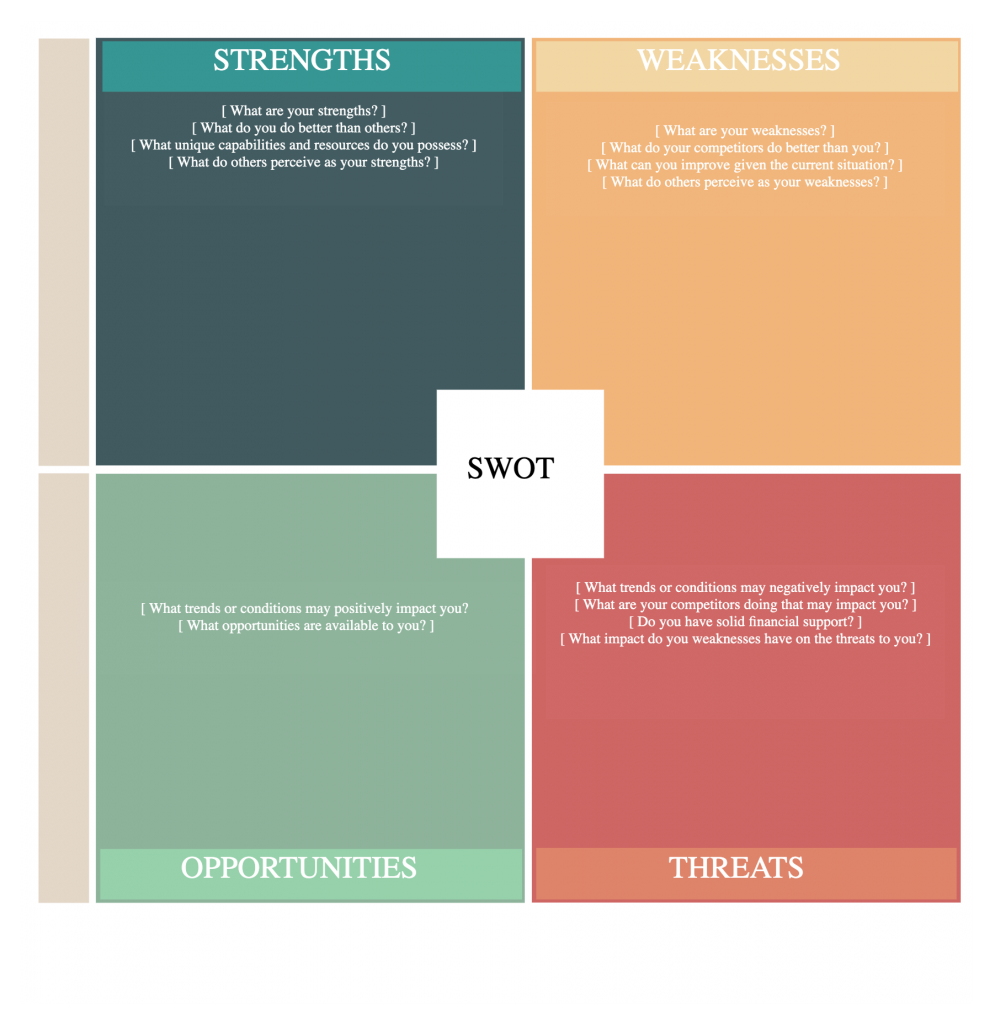
PESTLE Analysis
The PESTLE analysis is another environmental scanning techniques that help provide insight into the external situation of an organization from many different angles. It focuses on political, economic, social, technological, legal and environmental factors.
Political factors – impact of government policies, trading policies or elections
Economic factors – impact of economic trends, taxes, or import/export ratios
Social factors – impact of demographics, lifestyles, or ethnic issues
Technological factors – impact of advancing technology or technology legislations
Legal factors – impact of employment laws or health and safety regulations
Environmental factors – impact of climate change or environmental regulations

More Resources
STEEPLE analysis is a strategic management method that is used to examine the external factors affecting the growth and performance of an organization. It is a variant of the popular PESTLE analysis.
Porter’s Five Forces
Porter’s five forces technique is used to analyze the competitive environment. It looks at the following areas that may affect an organization’s competitive position,
- Supplier power
- Buyer power
- Competitive rivalry
- The threat of substitution
- The threat of new entry
Analyzing these factors help understand the power of competition in the industry/ market and how profitable it is to compete in it.
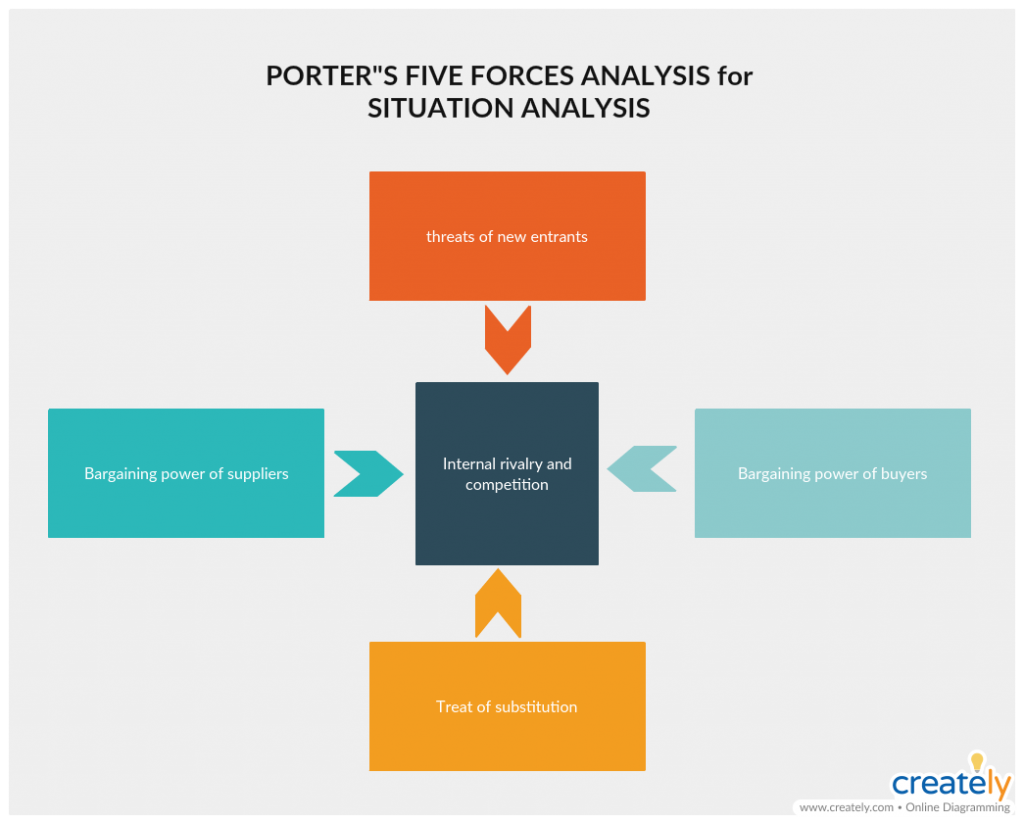
5 C Analysis
This tool helps assess the organizational environment from 5 different areas that may affect your marketing decisions .
- Customers; market segments, customer requirements and demands, market size and growth, retail channel and information sources, buying process, consumer trends, etc.
- Competitors; current and potential customers, customer products and positioning, their strengths and weaknesses, market share etc.
- Company; products or services, brand image, goals, company culture, strengths and weaknesses, technology and experience etc.
- Collaborators; distribution channels/ distributors, suppliers, alliances etc.
- Climate; political factors, economic factors, socio-cultural factors, technological factors, environmental factors, and legal factors
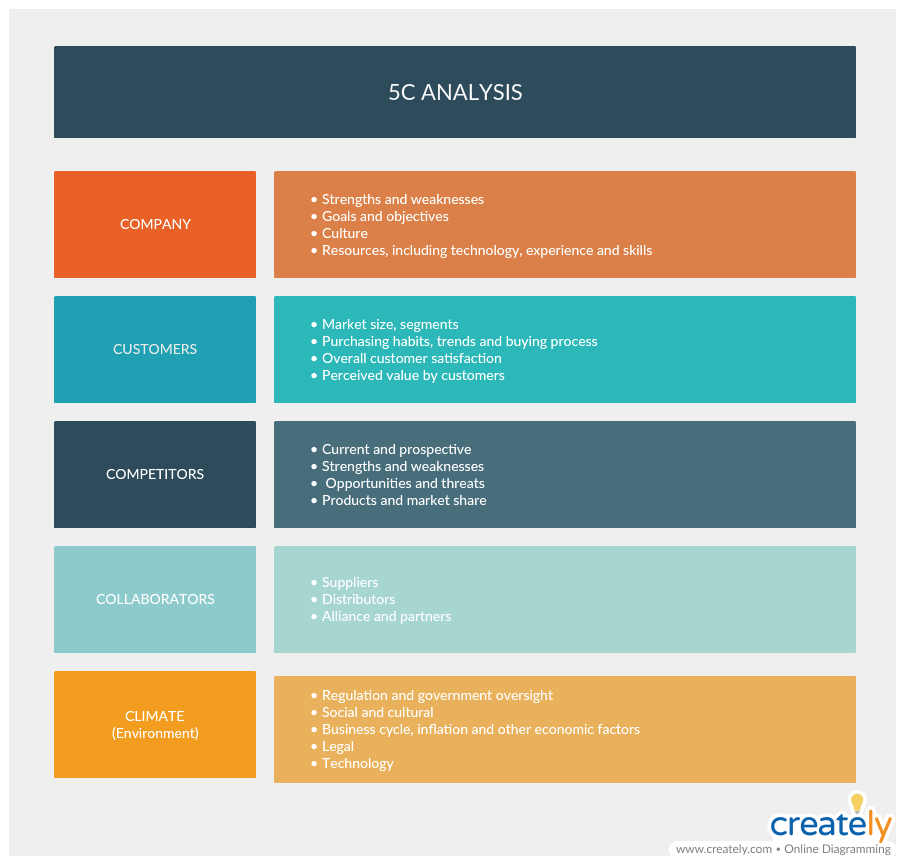
VRIO Analysis
The VRIO analysis is another tool that can be used to evaluate the resources of a company such as financial resources, human resources etc. It Stands for Value, Rareness, Imitability, Organization .

Learn how to use the VRIO analysis and get more templates with this resources on VRIO analysis examples .
What’s Your Approach to Conducting a Situation Analysis?
We’ve covered what is a situation analysis, how to perform one with helpful tools that you can use along with editable templates.
If you have any other tips, please do share them with us in the comment section below.
Join over thousands of organizations that use Creately to brainstorm, plan, analyze, and execute their projects successfully.

More Related Articles

A very helpful article. Thanks
Leave a comment Cancel reply
Please enter an answer in digits: thirteen − 6 =
Download our all-new eBook for tips on 50 powerful Business Diagrams for Strategic Planning.
Situational Analysis: Definition, Methods, Process, Examples
Appinio Research · 27.03.2024 · 31min read

Ever wondered how businesses make strategic decisions? How do they navigate through complex environments and stay ahead of the competition? The answer lies in situational analysis. In simple terms, situational analysis is like taking a snapshot of where a business stands right now and understanding the world around it. It's about examining both the inside and outside factors that can influence an organization's success. By dissecting internal strengths and weaknesses alongside external opportunities and threats, businesses gain valuable insights to guide their decision-making process. It's a crucial tool for anyone looking to understand the big picture of a business environment and make informed choices.
What is Situational Analysis?
Situational analysis, often referred to as environmental scanning or SWOT analysis, is the process of assessing the current state and dynamics of an organization's internal and external environment. It involves evaluating various factors that can influence the organization's performance, opportunities, and threats. The purpose of situational analysis is to provide decision-makers with valuable insights to inform strategic planning, resource allocation, and risk management.
Importance of Situational Analysis
Situational analysis plays a vital role in strategic decision-making and organizational management. Here are some key reasons why it is important:
- Informed Decision-Making: By providing a comprehensive understanding of internal strengths, weaknesses, and external opportunities and threats, situational analysis enables decision-makers to make informed and evidence-based decisions.
- Strategic Planning: Situational analysis forms the foundation for strategic planning by identifying strategic priorities, setting objectives, and aligning resources with organizational goals.
- Risk Management: Situational analysis helps mitigate risks and develop contingency plans to address unforeseen challenges by identifying potential risks and threats facing the organization.
- Resource Allocation: Situational analysis informs resource allocation decisions by identifying areas of opportunity and areas of improvement within the organization.
- Competitive Advantage: Understanding the competitive landscape and market dynamics allows organizations to capitalize on strengths and differentiate themselves from competitors.
- Adaptation to Change: In a rapidly evolving business environment, situational analysis helps organizations anticipate changes, adapt to new trends, and stay ahead of the competition.
Overview of the Situational Analysis Process
The process of conducting situational analysis involves several key steps to ensure thoroughness and accuracy. Here's an overview of the typical process:
- Define Objectives and Scope: Clearly define the objectives of the situational analysis and establish the scope of the assessment.
- Gather Relevant Data : Collect data from internal and external sources, including financial reports, market research studies, and competitor analyses.
- Analyze Internal and External Factors: Evaluate internal factors such as strengths, weaknesses, and resources, as well as external factors such as market trends, competitive dynamics, and regulatory changes.
- Conduct SWOT Analysis : Synthesize the findings of internal and external analysis to identify strengths, weaknesses, opportunities, and threats facing the organization.
- Interpret Findings: Analyze the situational analysis results to uncover insights, patterns, and implications for the organization.
- Formulate Strategies: Develop strategic initiatives and action plans based on the insights gained from the analysis.
By following this structured process, organizations can gain valuable insights into their current situation and make informed decisions to drive success and achieve their strategic objectives.
The Components of Situational Analysis
Situational analysis involves delving into both internal and external factors that can affect your organization. Let's explore each component in detail.
Internal Analysis
Internal analysis focuses on evaluating the strengths, weaknesses, and resources within your organization. This self-assessment is crucial for understanding your organization's capabilities and limitations.
When conducting internal analysis, consider various aspects of your organization, including:
- Human Resources: Assess your workforce's skills, expertise, and effectiveness. Determine if there are any skill gaps or areas for improvement.
- Financial Resources: Evaluate your organization's financial health, including revenue streams, profitability, and cash flow. Identify any financial constraints or opportunities for investment.
- Operational Efficiency: Analyze your business processes and operations to identify inefficiencies or areas for optimization. Look for ways to streamline workflows and reduce costs.
- Brand Reputation: Assess the perception of your brand in the market. Consider factors such as brand awareness, customer loyalty, and reputation management.
- Product or Service Quality: Evaluate the quality of your products or services compared to competitors. Identify any areas where improvements can be made to enhance customer satisfaction.
- Organizational Culture: Examine your organization's values, norms, and behaviors. Determine if your culture supports your strategic objectives or if changes are needed.
By conducting a thorough internal analysis, you can gain insights into your organization's core strengths and weaknesses, enabling you to make informed decisions and allocate resources effectively.
External Analysis
External analysis involves assessing the external environment in which your organization operates, including market conditions, competitors, and regulatory factors. This analysis helps you understand the opportunities and threats facing your organization.
- Market Trends: Identify emerging trends and shifts in consumer behavior that could impact your industry. Stay abreast of technological advancements, changing demographics, and evolving market preferences.
- Competitive Landscape: Analyze your competitors' strategies, strengths, and weaknesses . Identify key competitors and assess their market positioning, product offerings, and pricing strategies.
- Regulatory Environment: Stay informed about regulations and compliance requirements relevant to your industry. Understand how changes in legislation or government policies could affect your business operations.
- Economic Factors: Consider macroeconomic indicators such as GDP growth, inflation rates, and unemployment levels. Understand how economic fluctuations can influence consumer spending patterns and market demand.
- Social and Cultural Factors: Take into account societal trends and cultural norms that may impact your business. These may include factors such as demographic shifts, lifestyle changes, and social values.
- Technological Advancements: Evaluate technological developments that could disrupt your industry or create new opportunities. Consider the impact of innovations such as artificial intelligence, blockchain, and the Internet of Things.
By conducting external analysis, you can identify potential opportunities for growth and innovation, as well as anticipate threats that may jeopardize your organization's success. This proactive approach enables you to adapt to changes in the external environment and stay ahead of the competition.
SWOT Analysis
SWOT analysis is a strategic planning tool that combines the findings of internal and external analysis to identify strategic priorities and develop actionable insights.
- Strengths: Internal factors that give your organization a competitive advantage. These could include factors such as strong brand equity, proprietary technology, or a loyal customer base.
- Weaknesses: Internal factors that place your organization at a disadvantage compared to competitors. These could include factors such as poor brand reputation, limited financial resources, or outdated technology.
- Opportunities: External factors that could be leveraged to your organization's advantage. These could include emerging market trends, changes in consumer behavior, or technological advancements.
- Threats: External factors that could pose risks or challenges to your organization's success. These could include factors such as intense competition, economic downturns, or regulatory changes.
By conducting a SWOT analysis, you can gain a comprehensive understanding of your organization's internal strengths and weaknesses and the external opportunities and threats facing your business. This insight enables you to develop strategies that capitalize on your strengths, address your weaknesses, seize opportunities, and mitigate threats, ultimately positioning your organization for success.
Situational Analysis Methods and Tools
To conduct a comprehensive situational analysis, you'll need to employ various methods and tools to gather and analyze relevant data. Let's explore some effective techniques for conducting situational analysis.
Market Research Techniques
Market research techniques play a crucial role in gathering insights into your target market, customers, and competitors. By employing these techniques, you can gain a deeper understanding of market dynamics and identify key trends and opportunities.
Surveys are a popular market research technique used to collect data from a large sample of respondents. Surveys can be conducted through various channels, including online surveys, telephone interviews, or paper-based questionnaires. By asking targeted questions, you can gather valuable insights into consumer preferences, purchase behavior, and satisfaction levels.
When designing surveys , it's essential to ensure that questions are clear, concise, and relevant to your research objectives. Consider using closed-ended questions with predefined response options to facilitate data analysis. Additionally, consider conducting pilot tests to refine your survey instrument and ensure its effectiveness.
Interviews provide an opportunity to conduct in-depth conversations with key stakeholders, including customers, industry experts, and internal staff. Unlike surveys, interviews allow for open-ended discussions, enabling you to explore topics in greater detail and uncover nuanced insights.
When conducting interviews, prepare a list of questions in advance, but be flexible and responsive to the interviewee's responses. Use active listening techniques to engage with the interviewee and encourage them to share their perspectives and experiences. Additionally, interviews should be recorded for later analysis and reference.
Focus Groups
Focus groups bring together a small group of individuals to participate in a facilitated discussion on a specific topic or issue. By harnessing the collective wisdom of participants, focus groups can generate rich qualitative data and uncover deep-seated attitudes and opinions.
When organizing focus groups, recruit participants representing your target market and ensure diversity in demographics and perspectives. Facilitate discussions using open-ended questions and prompts, allowing participants to express their thoughts freely. Consider using techniques such as brainstorming or role-playing to stimulate conversation and generate new ideas.
Data Analysis Tools
Data analysis tools are instrumental in organizing, analyzing, and interpreting the data collected during situational analysis. These tools enable you to uncover patterns, trends, and relationships within your data, facilitating evidence-based decision-making and strategic planning.
SWOT Analysis Grids
SWOT analysis grids provide a structured framework for organizing and visualizing the findings of your situational analysis. By categorizing strengths, weaknesses, opportunities, and threats into a matrix format, SWOT analysis grids allow you to identify strategic priorities and develop actionable insights.
When creating a SWOT analysis grid, list key factors under each category and assess their significance and impact on your organization. Use color coding or visual elements to highlight critical findings and trends. Additionally, consider conducting a SWOT analysis collaboratively with key stakeholders to gain diverse perspectives and foster buy-in for strategic initiatives.
PESTLE Analysis
PESTLE analysis is a strategic tool for evaluating the external factors influencing your organization's operating environment. PESTLE stands for Political, Economic, Social, Technological, Legal, and Environmental factors, which collectively shape the macroeconomic landscape in which your organization operates.
When conducting a PESTLE analysis, systematically assess each factor and its potential impact on your organization. Consider how political changes, economic trends, social dynamics, technological advancements, legal regulations, and environmental concerns could affect your business operations and strategic objectives. Use the insights gained from PESTLE analysis to anticipate risks, identify opportunities, and adapt your strategies accordingly.
Porter's Five Forces Model
Porter's Five Forces model is a framework for analyzing the competitive dynamics of an industry. Developed by Harvard Business School professor Michael Porter, this model identifies five forces that shape the intensity of competition within an industry:
- The threat of new entrants
- The bargaining power of buyers
- The bargaining power of suppliers
- The threat of substitutes
- The rivalry among existing competitors
When applying Porter's Five Forces model, assess each force's strength and its implications for your organization's competitive position. Consider factors such as barriers to entry, buyer power, supplier power, substitute products or services, and competitive rivalry. Use the insights gained from this analysis to develop strategies that capitalize on your strengths and mitigate competitive threats.
By leveraging market research techniques and data analysis tools, you can gain valuable insights into your organization's internal and external environment, enabling you to make informed decisions and develop effective strategies for success.
How to Conduct Situational Analysis?
Conducting a comprehensive situational analysis requires a systematic approach that encompasses several steps. Let's explore each step in detail to ensure you gather actionable insights and formulate effective strategies.
1. Define Objectives and Scope
Before embarking on a situational analysis, it's essential to clearly define your objectives and scope. What specific questions do you want to answer, and what aspects of your organization or environment do you want to assess? Defining clear objectives will guide your analysis and ensure you focus on gathering relevant data.
When defining objectives, you need to define your:
- Strategic Goals: What overarching goals or objectives are you aiming to achieve through the situational analysis?
- Areas of Focus: Which aspects of your organization or environment do you want to assess? This could include internal capabilities, market dynamics, competitive landscape, or regulatory factors.
- Key Questions: What specific questions do you want to answer? What insights are you seeking to gain from the analysis?
By clearly defining your objectives and scope, you can ensure your situational analysis is focused and targeted, enabling you to derive meaningful insights to inform your strategic decisions.
2. Gather Relevant Data
Once you've defined your objectives, the next step is to gather relevant data to support your analysis. This involves collecting information from both internal and external sources, including:
- Internal Data: Gather data from within your organization, such as financial reports, operational metrics, customer feedback, and employee surveys. Internal data provides insights into your organization's strengths, weaknesses, and resources.
- External Data: Collect data from external sources to understand market trends, competitor strategies, regulatory changes, and other environmental factors. External data helps you assess opportunities and threats facing your organization.
When gathering data, consider the following:
- Data Sources: Identify the sources of data that are most relevant to your objectives. This could include primary sources (e.g., internal records, customer surveys) and secondary sources (e.g., industry reports, market research studies).
- Data Quality: Ensure the data you collect is accurate, reliable, and up-to-date. Take steps to verify the validity of the data and address any potential biases or errors.
- Data Collection Methods : Choose appropriate methods for collecting data, such as surveys, interviews, focus groups, or data analysis tools. Consider the strengths and limitations of each method and select the most suitable approach for your objectives.
As you gather relevant data for your situational analysis, consider leveraging innovative tools like Appinio for comprehensive data collection. With its user-friendly interface and powerful analytics capabilities, Appinio streamlines the process of gathering insights from your target audience.
By tapping into Appinio's extensive network of respondents, you can quickly gather valuable data on consumer preferences, market trends, and competitor perceptions. With Appinio, you can gain deeper insights into your organization's position in the market and make data-driven decisions to drive strategic growth.
Ready to harness the power of data-driven insights? Book a demo with Appinio today to see how it can revolutionize your situational analysis process!
Book a Demo
3. Analyze Internal Factors
With data in hand, it's time to analyze internal factors that may influence your organization's performance and competitiveness. Internal analysis involves assessing your organization's strengths, weaknesses, and resources across various dimensions.
Key areas to focus on during internal analysis include:
- Human Resources: Evaluate your workforce's skills, expertise, and effectiveness. Assess training and development needs, talent retention strategies, and organizational culture.
- Financial Resources: Analyze your organization's financial health, including revenue streams, profitability, and liquidity. Identify areas for cost reduction, revenue growth, and investment.
- Operational Efficiency: Assess the efficiency and effectiveness of your business processes and operations. Identify bottlenecks, inefficiencies, and opportunities for improvement.
- Brand and Reputation: Evaluate your organization's brand image , reputation, and customer perceptions. Identify strengths to leverage and weaknesses to address.
- Product or Service Quality: Assess the quality, features, and performance of your products or services. Identify areas for innovation, differentiation, or enhancement.
- Technological Capabilities: Evaluate your organization's technological infrastructure, capabilities, and readiness for digital transformation. Identify opportunities to leverage technology for competitive advantage.
By thoroughly analyzing internal factors, you can identify critical strengths to leverage and weaknesses to address, informing your strategic decision-making process.
4. Analyze External Factors
In addition to internal factors, external factors that may impact your organization's performance and competitiveness must be analyzed. External analysis involves assessing the broader business environment, including market dynamics, competitive forces, regulatory factors, and societal trends.
Key areas to focus on during external analysis include:
- Market Trends: Identify emerging trends, shifts in consumer behavior, and market opportunities. Analyze factors such as technological advancements, demographic changes, and changing consumer preferences.
- Competitive Landscape: Assess the competitive dynamics of your industry , including your competitors' strategies, strengths, and weaknesses. Identify key competitors, their market positioning, and their impact on your organization.
- Regulatory Environment: Understand the regulatory landscape in which your organization operates. Identify regulatory requirements, compliance obligations, and potential risks or opportunities arising from changes in legislation or government policies.
- Economic Factors: Evaluate macroeconomic indicators such as GDP growth, inflation rates, and unemployment levels. Understand how economic fluctuations may impact consumer spending, market demand, and business investment.
- Social and Cultural Trends: Consider societal trends, cultural norms, and demographic shifts that may influence consumer behavior and market dynamics. Identify opportunities to align your products or services with changing societal values and preferences.
- Technological Disruptions: Assess technological advancements and disruptions that may impact your industry. Identify opportunities to leverage technology for innovation, efficiency, and competitive advantage.
By analyzing external factors, you can identify potential opportunities for growth and innovation, as well as threats that may pose risks to your organization's success.
5. Conduct SWOT Analysis
With internal and external factors analyzed, it's time to conduct a SWOT analysis to synthesize your findings and identify strategic priorities. SWOT analysis involves identifying your organization's strengths, weaknesses, opportunities, and threats, and using this information to develop actionable insights.
- Strengths: Internal factors that give your organization a competitive advantage. These could include factors such as strong brand equity, proprietary technology, or a talented workforce.
- Weaknesses: Internal factors that place your organization at a disadvantage compared to competitors. These could include factors such as limited financial resources, outdated technology, or poor brand reputation.
- Opportunities: External factors that could be leveraged to your organization's advantage. These could include factors such as emerging market trends, changes in consumer behavior, or advancements in technology.
By conducting a SWOT analysis, you can gain a deeper understanding of your organization's internal strengths and weaknesses, as well as the external opportunities and threats facing your business. This insight enables you to develop strategies that capitalize on your strengths, address your weaknesses, seize opportunities, and mitigate threats, ultimately positioning your organization for success.
6. Interpret Findings
Once you've conducted your analysis and identified key insights through the SWOT analysis, the next step is to interpret your findings. Interpretation involves synthesizing your data and insights to uncover patterns, trends, and implications for your organization.
- Key Themes: Identify recurring themes or patterns that emerge from your analysis. Look for commonalities across different data sources and dimensions.
- Critical Issues: Highlight critical issues or challenges facing your organization. Prioritize these issues based on their significance and potential impact.
- Strategic Implications: Consider the strategic implications of your findings. How do your strengths align with market opportunities? How can you mitigate weaknesses and address threats? What strategies can you develop to capitalize on emerging trends and leverage your competitive advantages?
Interpretation involves critically analyzing your findings in the context of your organization's strategic objectives and competitive landscape. It requires synthesizing quantitative data, qualitative insights, and expert judgment to draw meaningful conclusions.
7. Formulate Strategies
The final step in performing a comprehensive situational analysis is formulating strategies based on your findings and insights. Strategic formulation involves developing actionable initiatives and plans to capitalize on opportunities, mitigate risks, and achieve your organization's goals and objectives.
- Strategic Priorities: Identify the most critical issues and opportunities identified through your analysis. Prioritize these based on their impact and feasibility.
- Goal Alignment: Ensure your strategies align with your organization's mission, vision, and strategic objectives. Each strategy should contribute to the organization's overall direction and purpose.
- Resource Allocation: Allocate resources effectively to support the implementation of your strategies. Consider factors such as budgetary constraints, staffing requirements, and timeline constraints.
- Risk Management: Identify and mitigate potential risks and challenges associated with your strategies. Develop contingency plans and risk mitigation strategies to address unforeseen obstacles.
- Monitoring and Evaluation: Establish metrics and benchmarks to monitor the progress and effectiveness of your strategies. Regularly review and evaluate your performance to make adjustments as needed.
By formulating strategies informed by your situational analysis, you can position your organization for success in a dynamic and competitive environment. Strategic planning is an iterative process, so be prepared to adapt and refine your strategies based on changing circumstances and new insights.
Performing a comprehensive situational analysis is essential for organizations seeking to make informed decisions, mitigate risks, and seize opportunities in a rapidly evolving business landscape. By following these steps and leveraging appropriate methods and tools, you can gain valuable insights into your organization's internal capabilities and the external factors shaping its operating environment. This insight enables you to develop strategic initiatives that capitalize on strengths, address weaknesses, and position your organization for sustainable growth and success.
Situational Analysis Examples
Understanding situational analysis is best achieved through real-world examples that illustrate its application across various industries and organizational contexts. Let's look at some examples to provide a deeper insight into how situational analysis is conducted and its impact on decision-making and strategic planning.
Example 1: Retail Industry
In the retail industry, situational analysis is crucial for understanding market trends, consumer behavior, and competitive dynamics. For example, a retail company conducting situational analysis may:
- Internal Analysis: Assess its store performance, inventory management systems, and customer service levels to identify areas of improvement.
- External Analysis: Analyze market trends such as the rise of e-commerce, changing consumer preferences, and demographic shifts impacting purchasing behavior.
- SWOT Analysis: Identify strengths, such as a strong brand reputation, and weaknesses, such as high overhead costs. Explore opportunities like expanding into new markets and threats like intense competition from online retailers.
Based on the situational analysis's findings, the retail company may formulate strategies such as enhancing its online presence, optimizing inventory management systems, and launching targeted marketing campaigns to attract new customers and increase sales.
Example 2: Healthcare Sector
In healthcare, situational analysis is essential for healthcare providers to assess patient needs, regulatory requirements, and technological advancements. For instance, a hospital conducting situational analysis may:
- Internal Analysis: Evaluate patient satisfaction levels, staff productivity, and operational efficiency to identify areas for improvement.
- External Analysis: Examine regulatory changes such as healthcare reforms, advancements in medical technology, and shifts in patient demographics.
- SWOT Analysis: Identify strengths, such as specialized medical expertise, and weaknesses, such as outdated infrastructure. Explore opportunities such as offering telemedicine services and threats such as increasing competition from other healthcare providers.
Based on the situational analysis findings, the hospital may develop strategies such as investing in new medical equipment, expanding telemedicine capabilities, and enhancing patient engagement initiatives to improve overall healthcare delivery and patient outcomes.
Example 3: Technology Sector
In the technology sector, situational analysis helps organizations stay ahead of rapidly evolving market trends and technological advancements. For example, a software company conducting situational analysis may:
- Internal Analysis: Assess its product portfolio, research and development capabilities, and talent pool to identify areas for innovation.
- External Analysis: Analyze emerging technologies such as artificial intelligence, blockchain, and cloud computing, as well as competitive threats and market demand.
- SWOT Analysis: Identify strengths such as proprietary technology and weaknesses such as limited market presence. Explore opportunities such as entering new verticals and threats such as cybersecurity risks.
Based on the situational analysis findings, the software company may develop strategies such as investing in research and development, forging strategic partnerships, and diversifying its product offerings to capitalize on emerging opportunities and maintain its competitive edge in the market.
Situational Analysis Applications
Situational analysis isn't just a theoretical exercise; it has numerous practical applications across various aspects of business management.
- Business Strategy Development: Situational analysis forms the foundation for strategic planning by providing insights into internal strengths and weaknesses, as well as external opportunities and threats. Organizations use this information to formulate strategic initiatives, set objectives, and allocate resources effectively.
- Market Planning: Marketing teams utilize situational analysis to develop targeted marketing strategies that resonate with their target audience. By understanding market trends, consumer preferences, and competitive dynamics, organizations can tailor their messaging, promotions, and product offerings to meet customer needs and differentiate themselves from competitors.
- Risk Assessment and Management: Situational analysis helps organizations identify and mitigate risks that could impact their operations or performance. Organizations can anticipate potential challenges by assessing internal and external factors and develop contingency plans to minimize their impact.
- Decision-Making Support: Executives and managers rely on situational analysis to make informed decisions about resource allocation, investment opportunities, and strategic initiatives. By providing data-driven insights, situational analysis empowers decision-makers to assess alternatives, evaluate risks, and choose the most viable course of action.
Situational Analysis Best Practices
To ensure the effectiveness of your situational analysis, it's essential to follow best practices that maximize the value of your efforts.
- Define Clear Objectives: Clearly define the objectives of your situational analysis and establish the scope of the assessment. This ensures that your analysis remains focused and targeted, providing more actionable insights.
- Use a Multidisciplinary Approach: Situational analysis benefits from input from diverse perspectives and areas of expertise. Involve stakeholders from different departments and disciplines to provide a holistic view of your organization's situation.
- Regular Monitoring and Review: Situational analysis is not a one-time activity but rather an ongoing process. Regularly monitor changes in the internal and external environment and update your analysis accordingly to ensure its relevance and accuracy.
- Combine Quantitative and Qualitative Data : Utilize a mix of quantitative data (e.g., financial metrics, market research data) and qualitative insights (e.g., customer feedback and expert opinions) to provide a comprehensive understanding of your organization's situation.
- Involve Key Stakeholders: Engage key stakeholders throughout the situational analysis process to ensure buy-in and alignment with strategic objectives. Solicit input from employees, customers, suppliers, and other relevant parties to gain diverse perspectives.
- Communicate Findings Effectively: Clearly communicate the findings of your situational analysis to relevant stakeholders, including executives, managers, and employees. Use visualizations, summaries, and presentations to convey complex information in an accessible and understandable format.
- Iterate and Adapt: Recognize that the business environment is constantly evolving, and your situational analysis must adapt accordingly. Be prepared to iterate and refine your analysis as new information becomes available and circumstances change.
By following these best practices, you can ensure that your situational analysis is thorough, insightful, and actionable, ultimately helping your organization make informed decisions and achieve its strategic objectives.
Situational analysis serves as a compass for businesses, guiding them through the ever-changing market landscape. By examining internal factors like strengths and weaknesses alongside external elements such as opportunities and threats, organizations clearly understand their position and the challenges they face. Armed with this knowledge, they can chart a course toward success, leveraging their strengths, addressing weaknesses, and seizing opportunities while mitigating threats. Ultimately, situational analysis is not just a one-time task but a continuous process that empowers businesses to adapt and thrive in dynamic environments. By regularly assessing their situation, organizations can stay agile, responsive, and well-prepared to navigate uncertainties and capitalize on emerging opportunities. It's a strategic tool that empowers businesses to make informed decisions, stay ahead of the curve, and achieve their long-term goals in an ever-evolving world.
How to Easily Collect Data for Situational Analysis?
Introducing Appinio , the real-time market research platform revolutionizing how companies gather consumer insights for situational analysis. With Appinio, you can conduct your own market research in minutes, empowering you to make better data-driven decisions swiftly and efficiently.
Here's why Appinio is the go-to platform for situational analysis:
- From questions to insights in minutes: With our intuitive platform, you can design and launch surveys quickly, getting actionable insights in no time.
- No research expertise needed: Appinio's user-friendly interface makes market research accessible to everyone, regardless of their background or expertise.
- Global reach, local insights: Define your target group from over 1200 characteristics and survey consumers in over 90 countries, ensuring you get the diverse perspectives you need for comprehensive situational analysis.

Get free access to the platform!
Join the loop 💌
Be the first to hear about new updates, product news, and data insights. We'll send it all straight to your inbox.
Get the latest market research news straight to your inbox! 💌
Wait, there's more

05.04.2024 | 27min read
What is Field Research? Definition, Types, Methods, Examples

03.04.2024 | 29min read
What is Cluster Sampling? Definition, Methods, Examples

01.04.2024 | 26min read
Cross-Tabulation Analysis: A Full Guide (+ Examples)
Protect your data
This site uses cookies and related technologies for site operation, and analytics as described in our Privacy Policy . You may choose to consent to our use of these technologies, reject non-essential technologies, or further manage your preferences.
- Career Advice
- Situational Analysis: What It...
Situational Analysis: What It Is, Why It's Important and How to Do It
11 min read · Updated on July 25, 2023

Fuel success and drive growth in an ever-changing business landscape
Performing situational analysis can be seen as an art: it requires a combination of skill, intuition, and strategic thinking. Just as an artist carefully crafts their masterpiece, conducting a situational analysis involves meticulously gathering and analyzing information to create a clear and insightful picture of the current business landscape. It's not just about crunching numbers; it's about understanding the nuances, identifying patterns, and using that knowledge to make informed and effective decisions.
But what is situational analysis, why is it important, and how do you do it? Whether you're an experienced strategist or just starting to dip your toes into the world of business analysis, get ready to unleash the artistry of situational analysis in this article. We'll walk you through the ins and outs of this powerful technique, unraveling its significance and guiding you through the processes that will allow you to wield data and insights with finesse, transforming them into the very brushstrokes of business success.
What is situational analysis?
Situational analysis is like a magnifying glass for your business or company. It gives you the power to see beyond the surface and dive into the core of your organization's current state. It can also be compared to a GPS for decision-making, as it guides you through the intricate twists and turns of the business. In fact, situational analysis can be used in every corner of business, including internal and external factors that shape the future of your success. From your company's strengths and weaknesses to dynamic market forces and industry trends , nothing escapes the watchful eye of situational analysis.
SWOT vs. situational analysis: understanding the distinctive duo
Before we dive deeper, let's clear up some potential confusion. A lot of people think that SWOT (Strengths, Weaknesses, Opportunities, and Threats) analysis is the same as situational analysis. Instead, SWOT is one of the situational analyst's trusty sidekicks – not the whole deal.
Situational analysis takes a step back to see the bigger picture, involving a more comprehensive evaluation of your overall business situation. So, while SWOT shines a spotlight on internal factors, situational analysis brings the whole cast onto the stage – internal, external, and everything in between.
Objectives and benefits
When you perform situational analysis, you're able to tackle problems head-on and make better-informed decisions. It also helps you to spot profitable opportunities. In the realm of business, a well-put-together situational analysis is like having a secret weapon in your pocket full of valuable insights, that you can pull out to smoke the competition. Key benefits include:
Making informed decisions
When you take a look into every nook and cranny of your organization, you become armed with information about everything from your company's current position to the surrounding market dynamics. You'll see some job postings out there that call for folks who know how to make data-driven decisions . Well, this is what they're talking about. The details you get from gathering and analyzing data allow you to make those coveted data-driven decisions, weighing the benefits and risks and aligning strategies with long-term business objectives.
Adapting to change
The knowledge from your analysis also allows you to anticipate challenges and capitalize on opportunities. If there's one constant in business, it's that things change. Armed with the power of situational analysis, you can guide your organization to adapt swiftly in response to competitor and market changes.
Spotting lucrative opportunities
If your organization is in business to make money, then being able to identify opportunities is extremely important. By analyzing market trends, customer preferences, and emerging technologies, you'll uncover vast opportunities waiting to be seized.
And guess what? It's not just about new possibilities – situational analysis reveals untapped potential. Discovering hidden talents and resources can lead to innovative breakthroughs that set you apart from the competition.
Tackling threats head-on
There is a world of factors that influence the ebb and flow of business. When you perform a situational analysis, you gain valuable tools that you can use to address potential problems before they get too big to handle. You're able to identify threats at an early stage, assess their severity and potential impact, allocate resources to address them and develop a strategic response. You're also in a good position to put contingency plans in place to handle unforeseen challenges - if your company doesn't have a Plan A, Plan B, and Plan C, they're set up for failure.
The four Cs of situational analysis
We've arrived at the core of situational analysis. The four Cs (Context, Conditions, Capabilities, and Competitors) are your compass for navigating business terrain.
Context is all about understanding the backdrop against which your organization operates, encompassing strengths, weaknesses, and operational capabilities. It involves analyzing the internal aspects of your company (like financial health, resources, and talent pool) and gaining a profound comprehension of its mission, vision, values, and culture. Beyond that, context extends its gaze externally, capturing the broader economic landscape that shapes your business environment. You have to know what's going on externally, so you can adapt and stay ahead of the curve.
2. Conditions
Conditions are like the tides of the business ocean - ever-changing and influential. To stay afloat, you must gauge the market climate with precision. Analyze industry trends, customer behavior, supply and demand, pricing, and emerging opportunities that could propel your organization forward.
3. Capabilities
These are your company's inner strengths. You'll find out what these are by analyzing your team's expertise, the company's technological prowess, and the operation's overall efficiency. Capabilities are also influenced by organizational weaknesses. As you embrace strengths and shore up weaknesses, you'll approach well-rounded and eye-opening strategies for business success.
4. Competitors
Have you heard the saying, " Keep your friends close and your enemies closer ?" That's what you're doing here. Study your competitor's strategies, strengths, and weaknesses to anticipate their moves and maintain a competitive edge. But remember, competition isn't just about winning; it's about spotting opportunities amid rivalries. Analyze gaps in the market that your competitors may have overlooked. Simultaneously, be vigilant of their advances, identifying potential threats that could challenge your market position.
The five parts of a situational analysis
Now that you know what's involved in performing situational analysis, you need to know how to write one. There's a step-by-step formula that's considered the foundation of a good situational analysis - it contains five parts as follows.
1. Market analysis
This is where you define your target audience . You have to find out who they are, what they want, and what pain points your company can address for them. When you understand your potential customers, you'll be equipped to deliver products and services that meet their needs. The best way to approach identifying your target audience is to create segments. By dividing your target audience into distinct groups, based on things like demographics, preferences, and behaviors, you can create buying personas. Crafting buyer personas brings your customers to life, making them relatable characters that shape your decision-making journey.
2. Industry analysis
Your situational analysis is still externally focused, at this point, guided by things that are going on with competitors, the industry, and technological breakthroughs. Understanding things like regulatory shifts can help you to identify your market position and influence the direction of your organization's journey.
3. SWOT analysis
Remember we said that SWOT is just a part of overall situational analysis? Well, here's where it comes into play. At this stage, your analysis is internally focused and your goal is to identify internal strengths that set you apart, pinpoint weaknesses that require fortification, seize opportunities that beckon, and defend against lurking threats. Align your SWOT findings with your strategic objectives.
4. PESTEL analysis
Think of SWOT as a micro-view of your organization. Conversely, PESTEL (Political, Economic, Social, Technological, Environmental, and Legal) is a macro view - the big picture. It's more than a checklist of external factors, it's an ever-changing process that requires constant vigilance and adaptability. PESTEL can create ripples across your business landscape that presents opportunities and challenges that can come from things like political instability, economic growth, cultural shifts in consumer behaviors, and environmental sustainability.
5. Stakeholder analysis
In order to conduct a comprehensive situational analysis, you have to know who the key players are. Stakeholder analysis will help you to identify and understand the individuals, groups, or organizations that have a significant impact on your operations and objectives. Each stakeholder brings unique needs, interests, and expectations to the table. They also often have diverse interests and conflicts may arise among them. Stakeholder analysis helps organizations to anticipate potential conflicts and identify areas of overlap or divergence. By addressing these conflicts proactively, organizations can mitigate risks, prevent negative outcomes, and maintain positive relationships.
Situational analysis example - the success story of TechHub Inc.
Let's put all of this knowledge to work with a case study of a situational analysis that guided TechHub Inc., a thriving tech startup, toward success and strategic brilliance.
TechHub Inc. is a growing technology startup that specializes in developing cutting-edge mobile applications. They have a team of innovative Engineers who define themselves as customer-centric. Now that the company is expanding its portfolio and venturing into new markets, leaders are conducting a comprehensive situational analysis to ensure success and align growth with organizational objectives and values.
Methodology
To conduct the situational analysis, TechHub Inc. adopted a systematic and data-driven approach, focusing on the five key parts of situational analysis: market analysis, industry analysis, SWOT analysis, PESTEL analysis, and stakeholder analysis.
- Market analysis: TechHub Inc. conducted an in-depth examination of its target audience, aiming to gain a holistic understanding of their needs and preferences. The team used market research surveys, customer feedback, and competitive analysis to identify emerging trends and consumer behavior patterns. The findings helped them to refine their product offerings and tailor their marketing strategies to better resonate with their target customers.
- Industry analysis: TechHub Inc. wanted to understand market positioning and identify opportunities for differentiation. This analysis involved evaluating competitors' strengths, weaknesses, and market share. The team also analyzed industry trends, technological advancements, and potential disruptions to stay ahead in the rapidly evolving tech market.
- SWOT analysis: A comprehensive SWOT analysis provided valuable insights into TechHub Inc.'s internal strengths and weaknesses, external opportunities, and potential threats. The company's strong product development capabilities, agile team, and customer-centric approach emerged as key strengths. However, the analysis also highlighted the need to address certain operational inefficiencies and potential challenges posed by increased market competition.
- PESTEL analysis: TechHub Inc. assessed the macro-environmental factors that could impact its business. Political stability, favorable economic conditions, and a growing demand for tech solutions were identified as positive influences. Simultaneously, the analysis revealed the importance of adhering to evolving environmental regulations and staying on top of rapid technological advancements.
- Stakeholder analysis: The company conducted a thorough stakeholder analysis to understand the interests and expectations of investors, customers, employees, partners, and regulatory bodies. By engaging with key stakeholders, TechHub Inc. built trust and fostered long-term relationships that supported its growth strategies.
Key findings and outcomes
The situational analysis proved instrumental in shaping TechHub Inc.'s growth trajectory and decision-making processes:
Refined product strategy: The market and industry analysis helped TechHub Inc. to identify a new market segment with untapped potential. They adapted their product strategy to cater to the specific needs of this segment, resulting in increased demand and market share.
Operational improvements: The SWOT analysis revealed specific areas for improvement within the company's operations. TechHub Inc. implemented streamlined processes, resulting in increased efficiency and reduced costs.
Strategic expansion: The PESTEL analysis highlighted emerging market trends and government policies. Using this information, TechHub Inc. successfully expanded its operations to new regions, capitalizing on growth opportunities.
Enhanced stakeholder engagement: The stakeholder analysis facilitated open communication with investors, leading to increased financial backing and support for new projects.
Achieve strategic brilliance
Situational analysis stands as a vital pillar in the world of strategic decision-making. Armed with the insights gained from the Five Parts and the Four Cs , you can navigate the complexities of your business landscape with confidence and foresight.
Let our resume writing services elevate your personal brand and highlight your expertise, so you can confidently stand out in the competitive job market and seize those career-defining opportunities! Why not submit your resume for a free review today?
Recommended reading:
6 Key Components of a Business Strategy and How Knowing Them can Help you to Succeed at Work
Marginal Analysis Skills Can Make You a Better Manager
First Mover Advantage
Related Articles:
Don't “Snowplow” Your Kids' Job Search — Set Them Up for Success Instead
What Kind of Job Candidate Are You?
Why December is the Best Time of Year to Look for a Job
See how your resume stacks up.
Career Advice Newsletter
Our experts gather the best career & resume tips weekly. Delivered weekly, always free.
Thanks! Career advice is on its way.
Share this article:
Let's stay in touch.
Subscribe today to get job tips and career advice that will come in handy.
Your information is secure. Please read our privacy policy for more information.
- Skip to main content
- Skip to primary sidebar
- Skip to footer
- QuestionPro

- Solutions Industries Gaming Automotive Sports and events Education Government Travel & Hospitality Financial Services Healthcare Cannabis Technology Use Case NPS+ Communities Audience Contactless surveys Mobile LivePolls Member Experience GDPR Positive People Science 360 Feedback Surveys
- Resources Blog eBooks Survey Templates Case Studies Training Help center
Home Workforce
Situational Analysis: What It Is, Importance + How to Conduct It
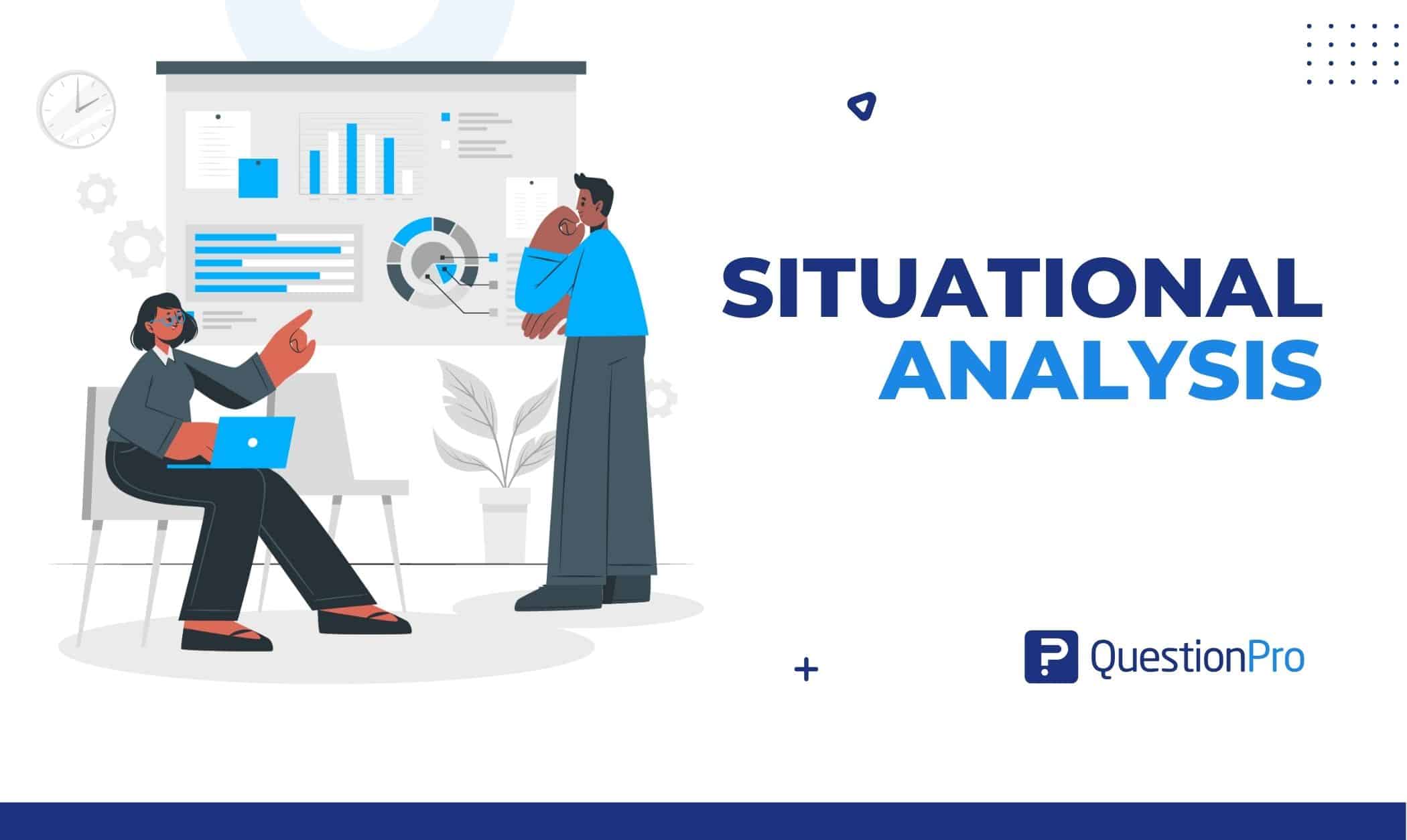
Successful companies understand how to locate and win market positions. But can every company take advantage of opportunities that may arise? Situational analysis assists a business in determining its strengths and weaknesses and how it can compete in the market.
In this blog, we will look at what situational analysis is, why it is important, and the procedure for conducting one.
What is situational analysis?
Situational analysis is the process of collecting, evaluating, and organizing information regarding an organization’s internal and external environments.
It involves evaluating the business’s strengths, weaknesses, opportunities, and threats ( SWOT analysis ). It may also include collecting and evaluating data about trends, consumers, competitors, and other external factors that may affect the organization.
The objective of situational analysis is to present a precise and accurate picture of the organization’s current state, which can be utilized to guide strategic planning and decision-making.
Situational analysis can be performed at any time, but it’s especially important before starting a new process or project. It helps you figure out the best way to move forward and avoid wasting time by doing things over or making wrong moves.
Why is situational analysis important in business?
Situational analysis is important for organizations because it helps them figure out where they are now and what opportunities and problems they might face. Some importance of conducting a situational analysis are as follows:
- Informing decision-making: Situational analysis helps decision-makers understand the possible results of different courses of action by collecting and analyzing information about the organization’s internal and external environment.
- Identifying strengths and weaknesses: It can help organizations understand their own strengths and weaknesses, which can help them create strategies and decide how to use their resources.
- Identifying opportunities and threats: It helps organizations find potential opportunities and threats and develop plans to deal with them by looking at trend analysis and outside factors that may affect the organization.
- Understanding the competitive landscape: As part of a situational analysis, doing a competitive analysis can help organizations understand the strengths, weaknesses, and strategies of their competitors. This can help organizations plan their own strategies.
- Providing a basis for strategic planning: It can be the basis for strategic planning and help organizations set clear smart goals and objectives by giving a complete picture of the organization’s current state.
- Getting the team involved and inspired: Great employees often leave stagnant companies because they see no use in working for the company in the long run. Situation analysis helps to spark discussion and new ideas among your team members.
- Setting business goals: Situational analysis gives organizations the insight to set achievable and beneficial objectives. Each analysis needs to have a plan for execution developed and authorized by decision-makers.
Tools and techniques of situational analysis
Organizations can use many different tools and techniques of situational analysis to evaluate and understand their internal and external environments. Here are some common types of this analysis:
1. SWOT analysis
SWOT analysis is a situational analysis process that involves evaluating strengths, weaknesses, opportunities, and threats. It’s a common approach to evaluating complicated situations.
- Strengths: Positive aspects of your company, products, services, and marketing initiatives.
- Weaknesses: Areas where your products, brand image and marketing initiatives can be improved.
- Opportunities: Includes suggestions for how you might succeed more, such as new methods of contacting customers or potential new markets.
- Threats: External factors that might have a negative impact on your profits or sales.
2. 5C’s analysis
The 5Cs analysis evaluates the internal and external factors affecting a company’s success. The 5C’s stand for:
- Company: This is about the organization’s resources, abilities, and processes.
- Customers: This refers to the people or businesses who make purchases of the company’s products or services.
- Competitors: This refers to other businesses in the same market that offer similar products or services.
- Collaborators: This refers to people or groups collaborating with the company, such as suppliers, partners, or distributors.
- Context: This refers to the organization’s operating environment as a whole, which includes economic, social, technological, and political elements.
3. Porter’s five forces
Porter’s Five Forces analysis helps companies assess their industry’s competitive forces and plan strategically based on their industry structure and suppliers’ and buyers’ power. These are the five forces:
- Competitive rivalry: It depends on how many competitors you have and how strong those competitors are. How strong your business is in the market is shown by its many competitors and how big those companies are.
- Threat of substitution: It relates to how easily a company’s product can be made again. A corporation has more market dominance and power if its good or service has no comparable alternatives.
- The threat of new entry: A company’s standing depends on how quickly new competitors can enter its field. When it’s easy to get into an industry and become a legitimate competitor, it weakens the power of all the businesses in that industry.
- Supplier power: An analysis of how easy it is for suppliers to raise prices. The number of suppliers of each vital input, their uniqueness, their size and strength, and the cost of switching suppliers determine this.
- Buyer power: An analysis of how easy it is for buyers to lower prices. The number of buyers, the importance of each buyer to the organization, and the cost of switching suppliers influence this. Few big purchasers can demand conditions from a corporation.
5. PESTLE analysis
PESTLE analysis is used to assess the external environment in which businesses operate. PESTLE stands for:
- Political: It includes the government’s stability, the regulatory environment, and any political influences on the organization.
- Economic: It includes economic growth, inflation, exchange rates, and unemployment.
- Social: It refers to the social and cultural standards and values of society, including demographics, workplace attitudes, and consumer behavior.
- Technological: It relates to an organization’s technological environment, including technological progress, change, and the impact of technology on products and services.
- Legal: It refers to an organization’s legal and regulatory environment analysis , including legislation that may affect its activities.
- Environmental: It refers to an organization’s physical environment, including its impact on the environment and how environmental challenges affect it.
5. VRIO analysis
VRIO analysis helps businesses determine which of their resources and skills are the most valuable and rare, as well as how they can be used to gain a competitive edge. VRIO framework stands for the following:
- Value: It means how much a company’s resources or skills help it create value for its customers.
- Rarity: It measures how unique a resource or skill is to the organization. If a resource or skill is hard to find, it may give you an edge over your competitors.
- Imitability: It is the degree to which another organization can copy or duplicate a resource or skill. If a resource or skill is hard to replicate, it may give you an edge over your competitors.
- Organization: It is how well a business can use its resources and skills to make money.
How to conduct situational analysis?
Conducting a situational analysis means gathering and analyzing information about an organization’s internal and external environment to understand its current situation and find potential opportunities and challenges.
Here are some steps you can take when performing a situational analysis:
01. Set the objective of the analysis
Determine the analysis’s particular goals and objectives, as well as the stakeholders that will be participating. This will assist you in concentrating your efforts and ensuring that the analysis is relevant and valuable.
02. Collect the necessary data
Gather necessary data from various sources, such as internal documents, industry reports, market research, and customer feedback . Consider using methods like interviews, surveys , and focus groups to learn more.
QuestionPro is an online survey tool to help you make better business decisions. It enables you to make the right changes with valuable analytics and insights about your workforce.
03. Analyze the data
Use situational analysis tools and techniques like SWOT analysis, 5C’s analysis, Porter’s five forces, PESTEL analysis , or VRIO analysis to figure out the most important trends, patterns, and problems that the data shows.
04. Identify the most important opportunities and challenges
Based on your analysis, list the most important opportunities and challenges the organization faces. Think about how these chances and issues will affect the organization’s goals and objectives.
05. Make suggestions and recommendations
Develop suggestions and recommendations for how the organization may take advantage of opportunities and handle challenges based on your findings. Think about the organization’s resources and competencies, as well as any potential risks or restrictions.
06. Report the findings
After reporting the analysis results, discuss the implications and recommendations with the relevant parties. Put the analysis findings to work in guiding the company’s future actions. Practical business intelligence relies on the synergy between analytics and reporting , where analytics uncovers valuable insights, and reporting communicates these findings to stakeholders.
Situational analysis can be complicated and take a lot of time, but it can give organizations valuable information and help them make smart decisions about their future.
How can QuestionPro help you in situational analysis?
QuestionPro creates and distributes surveys well. It has an easy wizard for designing survey questions, facilities for emailing or posting surveys, and tools for analyzing and viewing results. It helps organizations examine trends and patterns by gathering input and data from many individuals quickly and efficiently.
Here are some ways that QuestionPro can help businesses in situational analysis:
- Gathering customer feedback: QuestionPro survey software can collect customer feedback on product or service satisfaction, loyalty, and preferences. This can help organizations identify client demands and improve.
- Assessing employee satisfaction: QuestionPro can be used to survey employees on work happiness, engagement, and retention. This can assist companies in understanding employee demands and identifying areas for improvement.
- Identifying industry trends: QuestionPro can be used to ask industry professionals and other stakeholders about market trends and changes. This can help organizations comprehend their broader context and discover opportunities and challenges.
- Analyzing data: QuestionPro survey software contains analytics and reporting features to assist organizations in analyzing and comprehending their results. This can help organizations spot trends and make informed decisions based on the information.
QuestionPro can be a useful tool for businesses to collect and analyze data as part of a situational analysis. This helps them understand their internal and external environment and make smart decisions about their future direction.
Situational analysis can provide light on your company’s position in the market, what is working, what could be improved, and growth potential. Develop a marketing strategy, uncover market voids your business can fill, promote new technology, and react to rival changes using a situational analysis.
To better understand where your business is coming from and the direction it should take, modify the assessment as necessary.
QuestionPro workforce can be an excellent tool for organizations to acquire and evaluate data as part of a situational analysis, allowing them to understand their employees’ requirements and preferences better and make more educated decisions about workforce management approaches.
QuestionPro Workforce is a powerful tool for surveys and data analysis that will help you find out what process improvement surveys tell you.
BOOK A DEMO LEARN MORE
MORE LIKE THIS

Top 17 UX Research Software for UX Design in 2024
Apr 5, 2024

Healthcare Staff Burnout: What it Is + How To Manage It
Apr 4, 2024

Top 15 Employee Retention Software in 2024

Top 10 Employee Development Software for Talent Growth
Apr 3, 2024
Other categories
- Academic Research
- Artificial Intelligence
- Assessments
- Brand Awareness
- Case Studies
- Communities
- Consumer Insights
- Customer effort score
- Customer Engagement
- Customer Experience
- Customer Loyalty
- Customer Research
- Customer Satisfaction
- Employee Benefits
- Employee Engagement
- Employee Retention
- Friday Five
- General Data Protection Regulation
- Insights Hub
- Life@QuestionPro
- Market Research
- Mobile diaries
- Mobile Surveys
- New Features
- Online Communities
- Question Types
- Questionnaire
- QuestionPro Products
- Release Notes
- Research Tools and Apps
- Revenue at Risk
- Survey Templates
- Training Tips
- Uncategorized
- Video Learning Series
- What’s Coming Up
- Workforce Intelligence
- Learn center
- Project management
What is Situation Analysis, and why is it so important?
Georgina Guthrie
February 01, 2022
In the workplace, we tend to prize people who can make snappy decisions. But in reality, while this is a good trait to have in emergencies — like ‘should you run away from that falling tree?’ — it’s not so useful for long-term business decisions . Why? Because gut instinct is based on emotion, rather than logical reasoning. And while it definitely has value, it shouldn’t be your guiding light.
That’s not to say indecisiveness is a good thing. It just means decisions are better when they’re fully thought out. This is where a Situation Analysis comes in.
What is a Situation Analysis?
Situation Analysis is a process that helps you identify opportunities and challenges , both internal and external, to your organization, service, or product. You can also use it to define the scope of a problem.
Once you’ve worked these out, you can use your findings to help you plan a route from where you are right now to where you want to be.
You can conduct a Situation Analysis at any time, but it’s especially crucial before you implement a new process or start a project. It helps you work out the best course of action and move forward without wasting your efforts by repeating things or making false moves .
How to run a Situation Analysis in five steps
1. analyze your customers.
Customers or clients should be your focal point, so start by defining who this group is and their needs and challenges.
If this sounds like a big task, you’re right — it is! But don’t let that scare you. Set some time aside to work this out properly. You may already have a good idea, in which case, it’ll be a matter of updating and refining your previous findings. If you haven’t, then utilize tools like Google Trends , customer surveys, and data collection ( GDPR-compliant , of course) to learn more about your customers.
As part of this stage, you could also create a customer journey map , like the one below. This will help you work out issues and goals your customers have at specific points during their interaction with your business.
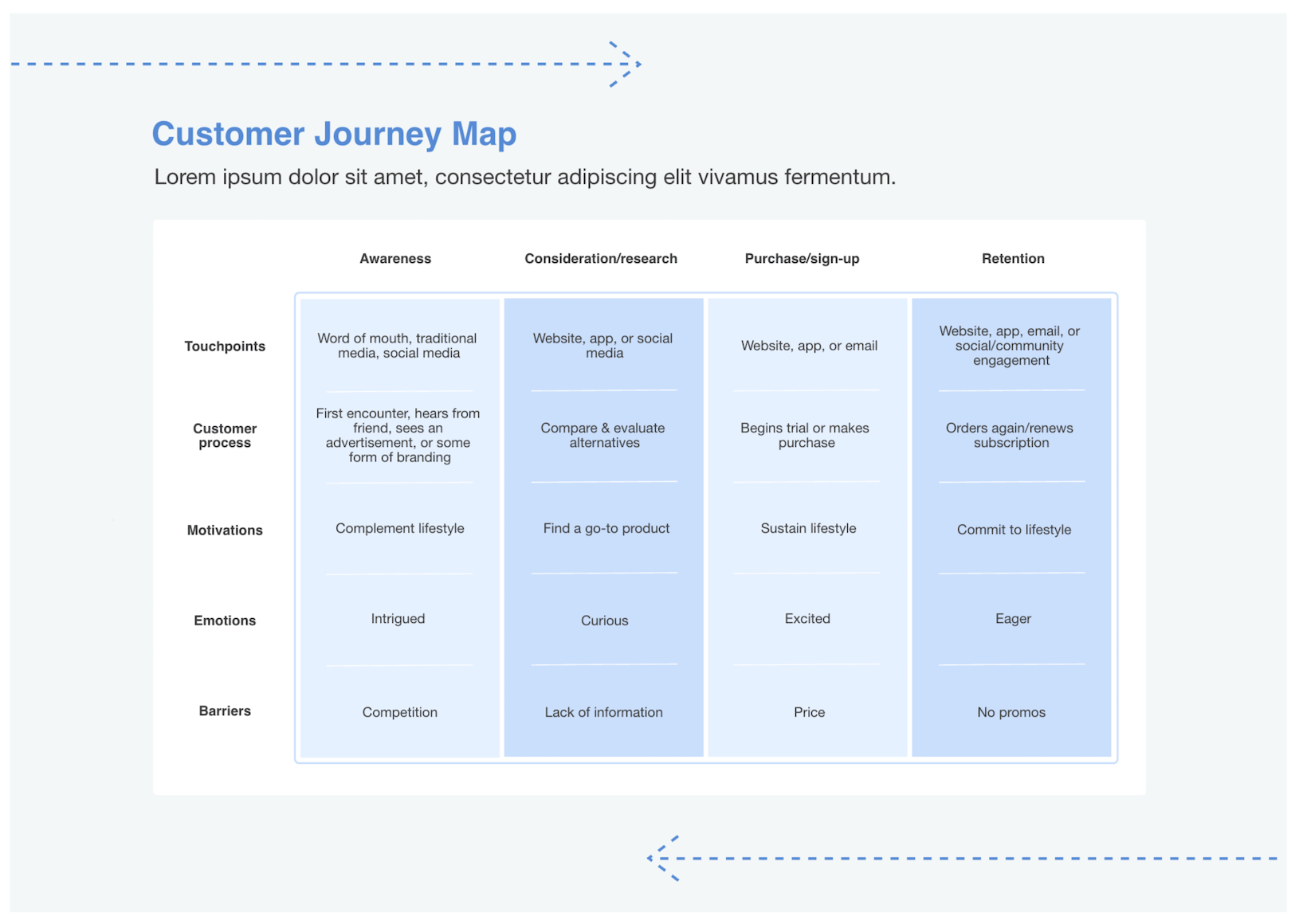

2. Analyze your products and services
It’s always good to take a step back and assess your current offering. Take note of all your products and services, and analyze whether they currently meet the demands of your customers or clients.
Again, a customer journey map can help you identify specific issues and opportunities. You can also collect customer feedback via reviews, surveys, interviews, or focus groups. As part of the assessment, you should review your suppliers and distributors (if applicable), as well as the tools and software you use.
A SWOT diagram can help you work out your business’s strengths, weaknesses, opportunities, and threats (which, as you’ve probably worked out, is exactly what S-W-O-T stands for).
You can also apply this tool to specific products or services within your business. The beauty of this technique lies in its simplicity. Just create a two-by-two grid (like the one below) and fill in the different sections.

3. Suss out the competition
Run a competitor analysis to see what others in the marketplace are doing, including their strengths and weaknesses. Once you’ve worked this out, you’ll be in a better position to compete.
You can do this stage as part of a 5C Analysis — a framework designed to help you assess your environment from five different areas, each of which impacts your business decisions.

- Customers (current and potential): note down their key features (i.e., age, hobbies, location, and anything else that’s relevant), as well as their needs, channels, and growth.
- Competitors : work out who your closest competition is, as well as their strengths and weaknesses.
- Company : analyze everything to do with your business, including your branding, market share, company culture , strengths, weaknesses (a SWOT chart will come in handy here), products, and services. Note how this compares to your biggest competitors.
- Collaborators : assess your current suppliers or distributors, influencers, marketers — in short, any external ties you have. You can also include technology and tools here.
- Climate : take a closer look at the market, including competitors, growth, recession, trends, opportunities, tech, and culture.
4. Analyze the environment
Take a step back and review your operational environment. Examine external factors, including economic trends that could affect you and/or your customers. Note down any potential or real threats or opportunities.
A PESTLE Analysis gives you insight into your company’s political, economic, sociological, technological, legal, and environmental situation. Again, a diagram can help you organize your thoughts here.
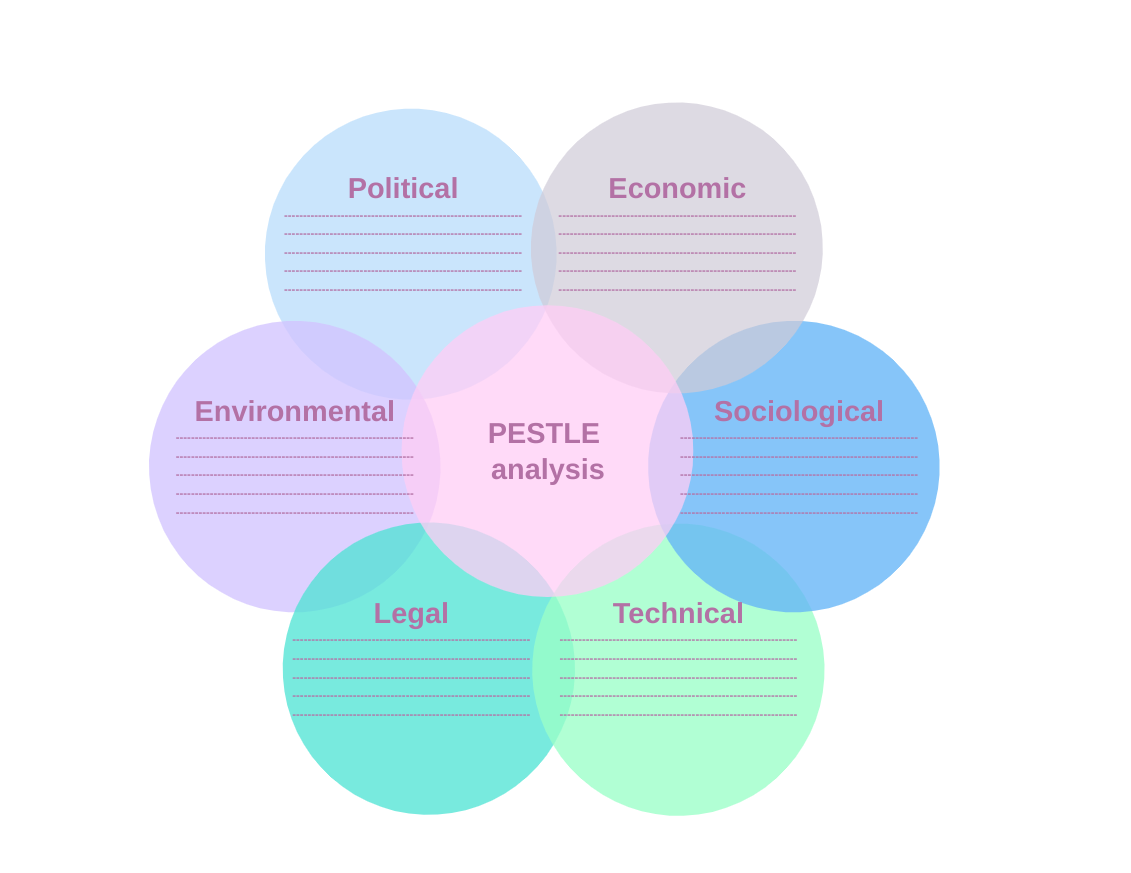
- Political : take note of current trading regulations and government policies. Consider how upcoming elections could influence these things.
- Economic : assess economic trends and import/export regulations that could affect your operations.
- Sociological : take into account any cultural movements and changes to your target demographic’s lifestyle.
- Technical : assess your technology and developments in the wider world. You should also include cybersecurity and changes to legislation here.
- Legal : examine legislative changes, including employment law.
- Environmental : look at how your business impacts the environment on a local and global scale. Consider how climate change could impact your business, and make sure you’re meeting current and upcoming regulations or have a compliance plan.
5. Assess your resources
Before you put your plans into action, you’ll need to know what you have at your disposal. If you have a team or work as part of one, find out who can help you and what their schedules are. Also, note down tools and budgets available to you, along with any limitations that could affect them.
A VRIO Analysis is a helpful tool for evaluating your ability to use organizational resources to their fullest potential. VRIO is an acronym for Value, Rarity, Imitability, and Organization. Here’s how to use it.
- Value : how valuable is a particular resource to your business success? Consider how the value compares to any short-term or long-term costs.
- Rarity : is the resource rare or easy to acquire? You have less flexibility in your business model when a resource is harder to obtain.
- Imitability : is the resource easy for competitors to imitate? If so, consider any adjustments you can make to differentiate your resources.
- Organization : is your business or team in a suitable position to leverage the resource? A resource that will take considerable investment or improvement to use increases your operating costs.
The VRIO framework can apply to a range of assets, including human resources, finances, information, property, and material goods. Evaluate each of the factors above in terms of:
- Competitive parity/equality
- Competitive disadvantage
- Temporary competitive advantage
- Unused competitive advantage
- Long-term competitive advantage
A VRIO Analysis allows you to see which resources are integral to your business and should be prioritized and managed as closely as possible. It also helps you decide when to outsource a resource or process or improve it to increase your competitive advantage. Once you have everything mapped out , you’re ready to roll.
The benefits (and limitations) of a situation analysis
Businesses of all sizes are vulnerable to market changes, and as they grow, there’s even more opportunity for something to go wrong. Performing a situational analysis can never harm your business but can certainly change it for the better. Here are a few ways to make use of it and mistakes to avoid along the way.
Understand the full scope of problems
All too often, managers are aware of organizational problems but assume they aren’t bad enough to require immediate attention. A thorough analysis can help you uncover the source of ongoing issues and evaluate their impact on different aspects of the business.
However, the subjective nature of a situation analysis makes it important to gather information from as many sources as possible. If you fail to gain a clear picture of your strengths and weaknesses, you won’t succeed at making your business more competitive. Use a combination of concrete data and feedback from internal and external stakeholders, so you can draw accurate conclusions.
Engage and motivate the team
Stagnant businesses are prone to losing great team members because there isn’t a meaningful vision for the future. Don’t simply look at a situation analysis as a decision-making tool; use it to get your team talking and innovating. Ultimately, your team has the most insight about what is or isn’t working in the business. Let them guide you toward opportunities you might otherwise overlook.
Reduce wastefulness
Knowing the ins and outs of the business is the only way to continuously refine your operations. Analyzing your resources, processes, and position in the market at least once a year allows you to cut out projects that aren’t profitable or beneficial to clients. If you face pushback from some stakeholders, the analysis provides data-based evidence for your decisions.
Set achievable business goals
A situation analysis gives you the insight to identify more realistic and advantageous goals. It’s an unfortunate blunder for business teams to conduct analyses but then do little with the information. For every analysis, develop an implementation plan and get sign-off from major stakeholders.
But don’t worry — you don’t have to act on everything that comes up in your evaluation. Prioritize fixing problems that are the biggest threats to your success and opportunities involving the most value and least expense or logistical effort.
Final thoughts
Displaying information visually makes it easier to process stats and large amounts of text, so get acquainted with the diagrams we’ve mentioned above and use them whenever you can.
If you plan to create diagrams as part of your Situation Analysis, make sure you’ve got the right tools for the job. The beauty of things like a SWOT diagram, 5C Analysis, and PESTLE Analysis is they’re easy to use . No training’s required, although we recommend using a dedicated tool for convenience.
Online diagramming tools make it easy to draw, edit, and share your creations, thanks to premade templates and cloud storage. This means you can spend less time formatting and file-finding and more time making good decisions.
This post was originally published on March 11, 2020, and updated most recently on February 1, 2022.

Business process optimization: what is it, and how do you do it?

Process improvement methods every project manager should know
Subscribe to our newsletter.
Learn with Nulab to bring your best ideas to life

What is situation analysis?
Reading time: about 9 min
Before launching into a new initiative or project, it’s important to come up with a plan. And part of that plan—the first part, in fact—should be conducting a situation analysis. At its core, situation analysis is a way to see how your business stacks up against competitors. It includes looking at several aspects of your business to help you make informed decisions as you grow your business.
So why is situation analysis so important to project planning and marketing strategies? Think of it this way: companies typically launch new projects or initiatives to build a new product, improve an existing one, or help connect their products to new and existing customers. But what happens if you do connect with customers and they don’t want or need your product? That’s months (maybe years) of work down the drain.
That's where a situation analysis can help.
While there’s no way to ensure the success of a product, situation analysis gives you the information you need to guide your business in the right direction. In this post we’ll cover the basic information you need to perform your own situation analysis.
What is a situation analysis?
Before getting into anything else, let’s address the question on everyone’s mind: What is situation analysis? We gave a brief answer in the intro, sure, but let’s really get into it.
Situation analysis is basically a methodical look at the internal and external factors influencing your business at any given moment. These factors might include customers, competitors, the market environment, and your business’s capabilities. By examining these elements of your business and its environment, you can identify strengths and weaknesses as well as potential areas of growth.
If this definition seems a little broad, that’s because it is: situation analysis is a broad term that encompasses several smaller activities. These activities include SWOT analysis, PESTEL analysis, Porter’s Five Forces, 5C analysis, and VRIO analysis (but more on those later). In other words, situation analysis is a phase of strategic planning, and during that phase, you might use several analytical tools.
Importance of situation analysis
We said it before and we’ll say it again, you should conduct a situation analysis before coming up with any concrete project plan or marketing strategy. But don’t worry, you don’t have to take us at our word—let’s break down exactly why situation analysis is so important in the early stages of planning.
Before anything else, situation analysis gives you a view of your business as it stands. No frills, no exaggeration, just an honest look at where you’re at. What are your strengths? Weaknesses? How do you compare to competitors? By performing a situation analysis, you’ll get a comprehensive view of your organization and its current state.
This can help shed light on other areas of your business. What problems are you facing? What strategies are you currently using to combat those problems?
With a well-rounded view of where your business is, you can get a better idea of where you want it to be. After performing situation analysis, you should be able to clearly identify your business’s current and desired states. From there, you can establish goals and take action to make your dream a reality.
Considerations within a situation analysis
To be effective, situation analysis needs to be thorough. A half-baked job simply won’t cut it. So what does a thorough situation analysis look like? For starters, it should look at your business from a variety of perspectives. But that’s the short answer. Let’s take a look at some of the key perspectives that go into situation analysis. As you perform situation analysis, you should consider:
- Product situation: This one’s pretty straightforward: what is your current product? In this instance it might be helpful to define “product” as all the ways you meet your customers’ needs. As you evaluate your current product, remember to also include any additional services you provide customers. Is your customer service top-notch? Because that certainly influences your product’s situation.
- Competitive situation: Situation analysis wouldn’t be complete without performing some form of competitor analysis. Your marketing strategy and business plan should always take competitors into consideration, and to do that, you’ll have to analyze where your competitors stand. (VRIO analysis can be a great tool for identifying long-term competitive advantage.)
- Distribution situation: How do you get your product to customers? This could be the app store, physical stores, etc. That’s your distribution situation. Your distribution mechanism can make or break your business—it is, after all, where you actually reach customers. Including it in your situation analysis can help you identify ways to better reach, engage, and retain customers.
- Environmental factors: You might not expect it, but environmental factors can be both internal and external. Internal environmental factors might include poor inter-company communication or changes in leadership and structure. External environmental factors are often wide-reaching: economic recessions, legal restrictions, etc. Stimulus checks are a timely example of an external environment factor.
- Opportunity and issue analysis: As you consider each of the previous situations, you’ll likely begin to identify your business’s strengths and weaknesses, and with those, opportunities and threats. To formalize and document this process, you should conduct SWOT analysis with your team.
Methods and diagrams for situation analysis
Remember how we said that situation analysis is a broad term that includes several smaller, more specific activities? It’s time to take a look at those smaller pieces that make up situation analysis.
There are five types of analysis typically used for situation analysis: SWOT analysis, PESTEL analysis, Porter’s Five Forces, 5C analysis, and VRIO analysis. Let’s take a closer look at each.
SWOT analysis
When it comes to strategic analysis, SWOT charts should be your bread and butter. SWOT is an acronym that stands for strengths, weaknesses, opportunities, and threats. As you perform SWOT analysis, you’ll think about your business from each of those standpoints and document your findings on a SWOT chart—four quadrants corresponding to each part of the acronym.

PESTEL analysis
Just like SWOT, PESTEL is an acronym. Each letter corresponds to a category of external factors that might influence your business: political, economic, social, technological, environmental, and legal factors. If you’re unsure what falls under each category, ask yourself the questions below as you move from category to category:
- Political factors: Are there government policies or trading restrictions that will impact your business?
- Economic factors: Is there an economic recession or boom? Did people get stimulus checks recently?
- Social factors: What lifestyle trends impact your business? What demographic are you trying to reach?
- Technological factors: Have there been any big tech advances in your industry? Any new legislation regarding your technology?
- Environmental factors: Are there environmental regulations that impact your industry? These could be emissions standards or something similar. ( This one may or may not be relevant, depending on your industry.)
- Legal factors: What health regulations impact the way you conduct business? Safety regulations? If there’s legislation that impacts your business, that’s a legal factor.
In PESTEL analysis, you consider how your business is impacted by each category of factors in turn. Record your findings on a PESTEL chart.

Porter’s Five Forces
First introduced by Harvard professor Michael E. Porter in the late 1970s, Porter’s Five Forces is an analytical method that helps you analyze your competition. The goal is to identify and eliminate (or avoid) competitive threats. According to Porter’s method, there are five forces that make up your competitive environment:
- Threat of substitute: Can a new product or service replace your product or service? If so, customers will have more options, and more options means you’ll have to have a competitive edge.
- Threat of new competitors: If new competitors enter the game, there’s a chance you’ll lose customers because they’ll have more options to choose from.
- Threat of established competitors: No matter how you cut it, rival businesses will always threaten your business. They are also vying to dominate the market, so you have to be better.
- Bargaining power of suppliers: If you’re dependent on a supplier, they have a lot of leverage over you. If they choose to raise prices, you don’t have any choice but to accept it or find a new supplier.
- Bargaining power of customers: How much does the customer depend on your product? If they don’t depend on it, what’s keeping them around?

5C analysis
In 5C analysis, you and your team will consider five factors impacting your business: the company, your competitors, your customers, your collaborators, and the climate. Let’s take a look at what each means:
- Company: Look at the internal aspects of your business. What are your goals and objectives? What are your products? Who is on your team?
- Competitors: Look at the other businesses in your industry. What are they doing to capture a share of the market? What are they doing differently than you?
- Customers: What are the demographics of your customers? Can you expand them?
- Collaborators: What suppliers and distributors do you depend on? Are there alternative options?
- Climate: What political, legal, and economic factors are influencing your industry and market?
VRIO analysis
If you’re trying to identify competitive advantages, VRIO analysis is the tool for the job. VRIO analysis is a method for evaluating your resources and the competitive advantages (or disadvantages) they give you. In VRIO analysis, you consider a resource from four perspectives:
- Is it valuable?
- Is it rare?
- Is it imitable?
- Are you organized to use it?

As you answer these questions, you’ll be able to determine if that resource gives you a competitive disadvantage, competitive parity, a temporary competitive advantage, an unused competitive advantage, or a long-term competitive advantage.
You may have noticed a common theme linking the five methods listed above: visuals. Like most analytical processes and methods, situation analysis is a whole lot easier when you visualize your information. Whether it’s through a SWOT chart, VRIO diagram, or simply a brainstorming board, Lucidspark can help your team stay organized and creative as you perform situation analysis.

Perform your own situation analysis in Lucidchart to propel your business forward.
About Lucidspark
Lucidspark, a cloud-based virtual whiteboard, is a core component of Lucid Software's Visual Collaboration Suite. This cutting-edge digital canvas brings teams together to brainstorm, collaborate, and consolidate collective thinking into actionable next steps—all in real time. Lucid is proud to serve top businesses around the world, including customers such as Google, GE, and NBC Universal, and 99% of the Fortune 500. Lucid partners with industry leaders, including Google, Atlassian, and Microsoft. Since its founding, Lucid has received numerous awards for its products, business, and workplace culture. For more information, visit lucidspark.com.
Related articles

In this introduction to PESTEL analysis, we’ll break down what a PESTEL analysis is, how and when to use it, and how it compares to another common business analysis tool—the SWOT analysis.

Here’s how to use a SWOT analysis to evaluate your business strategy to help your team make informed decisions.
Bring your bright ideas to life.
or continue with

- Certified Partner Agency
- Certified Training Partner
- Detroit HUG Leader
- HubSpot ROI Calculator
- HubSpot Fractional Services
- Marketing Solutions
- Sales Solutions
- Service Solutions
- Web Solutions
- Fractional Marketing
- Marketing Toolbox
- Resource Center
- ROI Calculators
- Website Grader
- Growth Services
- Marketing Automation
- Choosing an Inbound Marketing Agency
Situation Analysis Example and How to Write One

A situation analysis plays a pivotal role in shaping a marketing plan by providing a comprehensive understanding of both internal and external factors impacting your business and its marketing endeavors.
This crucial process involves assessing current market conditions, competitive landscape, customer behavior, and internal capabilities to uncover opportunities and challenges that will shape your marketing strategies. By grasping the key objectives, methodologies, and benefits of conducting a situation analysis, you will gain invaluable insights, empowering you to make well-informed decisions and devise effective marketing strategies that resonate with your target audience.
In this guide, we will walk you through how to write a situation analysis and provide you with an example that you can use to craft your own situation analysis for a marketing plan.
How to Write A Situation Analysis for a Marketing Plan
A situation analysis is a crucial step in crafting an effective marketing plan. It involves conducting a thorough assessment of various internal and external factors that can influence the success of your business and its marketing efforts. To start, gather relevant data and information about your company, industry, competitors, and target audience from various sources. Provide an overview of your business, including its mission, products, and unique selling propositions.
Next, analyze internal factors such as strengths and weaknesses to understand what advantages your business can leverage and where improvements are needed. Simultaneously, examine external factors like market conditions, industry trends, and the competitive landscape to identify potential opportunities and challenges.
When crafting a situation analysis, numerous factors come into play depending on your industry, goals, and audience. We will walk you through a professional example of a situation analysis that will serve as a solid foundation for your marketing plan.
Situation Analysis Example for a Marketing Plan
This is a situation analysis example for a manufacturing company. To make it your own, insert your industry, products, and services to tailor the situation analysis to your company.
Internal Analysis for a Situation Analysis
Strengths: [Company Name] possesses several strengths that contribute to its competitive advantage, such as strong manufacturing capabilities, a well-established brand reputation, a talented workforce, and robust distribution channels. These strengths position us favorably to introduce and promote [insert product or service here].
Weaknesses: Despite our strengths, we recognize certain weaknesses that need attention. These may include limited market share in specific regions, the need to enhance our digital marketing capabilities, and potential gaps in our product/service offerings that competitors may exploit. Addressing these weaknesses will be a priority to strengthen our marketing efforts.
External Analysis for a Situation Analysis
Market Trends: The [industry] is experiencing significant growth due to factors such as increasing demand for [insert product or service here], technological advancements, and evolving consumer preferences. We must capitalize on these trends and align our marketing strategies accordingly.
Competitive Landscape: The [industry] is highly competitive, with several established players and new entrants. Competitors may offer similar products or services, targeting the same customer segments. Analyzing competitor strategies, differentiators, and market positioning will help us identify opportunities and develop effective marketing strategies.
Customer Analysis: Our target customers include [describe the target audience]. It is essential to understand their needs, preferences, and purchase behaviors. Conducting market research and customer surveys will provide valuable insights that inform our marketing strategies, including product development, messaging, and distribution channels.
Regulatory and Legal Factors: Compliance with industry regulations, environmental standards, and intellectual property protection are critical considerations. Adhering to applicable laws and regulations ensures the integrity of our operations and strengthens our brand reputation.
Economic Factors: Economic conditions, such as inflation rates, consumer spending patterns, and purchasing power, can influence customer demand and purchasing decisions. Monitoring these factors will enable us to adjust pricing, promotional activities, and market positioning accordingly.
Based on this comprehensive situation analysis, [Company Name] can leverage its strengths, address weaknesses, and capitalize on market opportunities to effectively position and promote [insert product or service here]. By understanding the external market factors and aligning them with internal capabilities, we can develop targeted marketing strategies that drive customer engagement, increase market share, and ultimately lead to the success of our [insert product or service here].
Download the Situation Analysis Marketing Plan Template
Ready to kickstart your marketing planning process and create a roadmap for success? Now that you have learned how to write a situation analysis and have examined the situation analysis example download our free Create a Marketing Plan template ! This customizable template will guide you through the essential components of a comprehensive marketing plan, ensuring you effectively cover all crucial aspects, including the situation analysis. Don't miss out on this valuable resource – take the first step towards achieving your marketing goals by downloading our free template today !

SMART Marketing Objectives for Marketing Plans [Template and Examples]
Smart marketing objectives play a crucial role in shaping the direction and focus of a comprehensive marketing plan. They are specific, measurable,...

Implement Growth Marketing Strategies in Your Marketing Plan
Growth marketing strategies are the essential frameworks and approaches a marketing plan outlines to achieve specific marketing objectives. They...

The Importance of Implementing a Marketing Contingency Plan
Marketing contingency plans are an essential component of a comprehensive marketing plan, providing a proactive approach to handling unforeseen...
Ready to simplify your receipt and expense management process?
Enter your email to sign up for Expensify today!
Situational analysis: how to perform this crucial business research step

As a small business owner, you’re no stranger to the ebb and flow of the marketplace. The nature of business is ever-changing, and it can be tempting to make quick decisions in order to keep up with the competition. However, successful businesses don't just rely on gut feelings — they take their time, carefully assessing the big picture and making a plan before changing direction. This is where situation analysis comes into play.
In this article, we’ll take a look at what situational analysis is, why it’s important, and what you need to do to conduct one.
Sign up today to get started
What is a situational analysis?
A situational analysis is a methodical, investigative process used to understand the internal and external elements influencing a company's performance. Basically, a situational analysis evaluates several factors in order to identify a business’s strengths and weaknesses, as well as areas of growth.
It can help you uncover important details about your business and the overall marketplace, including:
Customer motivation and satisfaction
Your ability to capitalize on market trends
Your standing in relation to your competitors
Strategies to implement to overcome obstacles
You should always conduct a situation analysis before coming up with any concrete plan or shifting the direction of your business. But we also recommend conducting one on a regular basis, such as quarterly. And while you’re at it, you might as well add “situational analysis” to your end-of-year checklist , too — it’ll help you keep your finger on the pulse of the marketplace and empower you to make informed decisions throughout the year.
Why is situational analysis important?
Situational analysis is important because it provides a comprehensive snapshot of the current conditions and dynamics that affect your business at any given time. It empowers you to make decisions with a full understanding of internal capabilities and external environments, giving you a true “big picture” of your business and its market.
Situational analysis helps with risk management, strategic positioning, resource allocation, trend analysis, and opportunity identification. It empowers you to make informed decisions that directly impact your bottom line.
5 ways to complete a situational analysis
You can think of situation analysis as an umbrella term for other activities that need to be done in order to understand your business and its competition. Basically, situational analysis is a phase of strategic planning, and you might use several analytical tools during that phase.
So, what are those tools?
1. SWOT analysis
When it comes to situational analysis, SWOT is where most people start. It’s a great foundational process that allows you to take stock of your company’s strengths, weaknesses, opportunities, and threats. Once you’ve performed your SWOT situational analysis, you’ll get a comprehensive look at your company’s overall health.
Breaking down SWOT:
Strengths: Internal positive attributes that give your business an edge
Weaknesses: Internal limitations that need addressing
Opportunities: External chances for growth and improvement
Threats: External factors that could pose challenges
Tips to conduct a SWOT analysis:
List your company's core competencies and advantages.
Identify areas where your company has fewer resources or capabilities, and keep an eye out for ways to automate time-consuming tasks (like preaccounting ).
Look for emerging market trends or changes that could be advantageous.
Recognize potential obstacles such as regulatory changes or shifts in consumer behavior.
2. 5Cs analysis
The 5Cs analysis is similar to the SWOT analysis — but instead of evaluating the overall health of your business, the 5Cs create a framework for marketing and understanding your customer base.
What are the 5Cs?
Company: Your company's mission, vision, product quality, and unique selling points (Conducting a SWOT analysis first provides a good foundation for this C.)
Customers: Who they are, what they need, and how they behave
Competitors: Direct and indirect competitors and their market positions
Collaborators: Suppliers, distributors, and partners who contribute to your business
Climate: The macro-environmental factors affecting your business
Tips to conduct a 5Cs analysis:
Review your company’s internal resources and capabilities.
Gather customer feedback through surveys, social polls, or focus groups.
Analyze competitors’ strategies and market presence.
Evaluate current partnerships and supply chain effectiveness, and explore other partnerships and integrations if you find room for improvement.
Examine the broader market trends and economic conditions.
3. PESTEL analysis
A PESTEL analysis is all about understanding the environment in which your business operates. It examines key factors across several dimensions, offering insights into external influences that could impact your business strategy and decision-making processes.
PESTEL stands for:
Political: Government actions and policies that affect your business
Economic: Economic trends and their impact on consumer behavior
Social: Demographic and cultural aspects influencing your market
Technological: Technological changes and innovations
Environmental: Ecological concerns and regulations
Legal: Relevant laws and legal frameworks
Tips to conduct a PESTEL analysis:
Research political stability and policy changes in your market areas.
Analyze economic indicators like GDP growth and inflation rates.
Study social trends and shifts in consumer lifestyles.
Investigate new technologies and their potential disruptive effects.
Evaluate your company’s environmental impact and sustainability practices.
Review the legal landscape for possible liabilities.
4. Porter’s Five Forces analysis
Porter’s Five Forces analysis helps you understand and inspect your competition to see how you measure up and identify opportunities for improvement.
The Five Forces are:
Competitive rivalry: How intense the competition is in your industry
Supplier power: The influence suppliers have on your business
Buyer power: The impact of buyers’ choices on your operations
Threat of substitution: The possibility of customers finding alternative solutions
Threat of new entry: The ease with which new competitors can enter the market
Tips to conduct Porter’s Five Forces analysis:
Evaluate the level of competition and market saturation.
Consider your dependency on certain suppliers and possible alternatives.
Understand your customers' sensitivity to your pricing strategies and product quality.
Identify potential substitute products or services in your industry.
Assess barriers to entry for new players.
5. VRIO analysis
A VRIO analysis is your go-to tool for identifying your business’s competitive advantages. It helps you determine which of your resources and skills are the most valuable and unique, as well as how they can be used to gain a competitive edge.
VRIO stands for:
Value: Resources or capabilities that provide value to customers
Rarity: Offerings that are not available from competitors
Imitability: How easily competitors can replicate the offerings
Organization: Whether a company is structured to exploit these resources
Tips to conduct a VRIO analysis:
Identify resources and capabilities that differentiate you from competitors.
Consider the scarcity of these resources in the market and their value proposition.
Assess whether these resources can be easily copied or acquired by others.
Evaluate your company's readiness and ability to capitalize on its resources to ensure a competitive edge.
How to complete a situational analysis
We get it — that’s a lot of information to process. Fortunately, situation analyses are methodical processes, and when you break them down, it’s not too difficult to execute. Here’s how you can complete a situational analysis of your own business.
Set the objective of your analysis: Clearly outline what you hope to achieve with the analysis. Whether it's to refine marketing strategies, prepare for potential threats, or identify new market opportunities, clarity of purpose is key. Plus, it’ll help you decide which analysis to perform.
Collect data: Gather data about your company’s internal operations, market conditions, customer demographics, competitor behavior, and anything else that might be relevant to your objective. This data forms the basis of your analysis.
Analyze the data: This is where you get to have some fun. Using one of the methods above, dive deep into the collected data to identify patterns, trends, and anomalies.
Develop strategies: Based on your analysis, develop strategies that leverage strengths, mitigate weaknesses, capitalize on opportunities, and defend against threats.
Implement and monitor: Apply the strategies developed and continuously monitor their impact, adjusting as necessary to maintain alignment with your business objectives.
Another tip? Leveraging tools for financial planning and insights and reporting can streamline this process. Armed with the realtime data that this software provides, situational analysis becomes clearer and, ultimately, a whole lot faster.
Situational analysis is easier with the right tools
You don’t have to go it alone. With Expensify on your side, collecting and analyzing realtime data is easier than ever, so you can complete situational analysis regularly without any fuss.
Ready to make smarter business decisions in record time? Get started with Expensify today.
Planning for the future is easier with realtime automation.
Let Expensify be your business’s crystal ball.
Expensify values your privacy. We’ll never sell your personal information to others.

Michigan > Chicago > SF. Ghostwriter for Train. Waiting for the MySpace resurgence to recalibrate his Top 8. Loves takeout AND delivery. Personal goal: every Netflix session ends with "Are you still watching?".
- Expense Management
- Spend Management
- Expense Reports
- Company Card
- Receipt Scanning App
- ExpensifyApproved!
- ExpensifyHelp
- Expensify App
- About Expensify
- Expensify.org
- Investor Relations
Get Started
- Create a new account
©2008-2023 Expensify, Inc.
The Expensify Visa® Commercial Card is issued by The Bancorp Bank, N.A. pursuant to a license from Visa U.S.A. Inc. and may not be used at all merchants that accept Visa cards. Apple® and the Apple logo® are trademarks of Apple Inc., registered in the U.S. and other countries. App Store is a service mark of Apple Inc. Google Play and the Google Play logo are trademarks of Google LLC.
Money transmission is provided by Expensify Payments LLC (NMLS ID:2017010) pursuant to its licenses .

- school Campus Bookshelves
- menu_book Bookshelves
- perm_media Learning Objects
- login Login
- how_to_reg Request Instructor Account
- hub Instructor Commons
- Download Page (PDF)
- Download Full Book (PDF)
- Periodic Table
- Physics Constants
- Scientific Calculator
- Reference & Cite
- Tools expand_more
- Readability
selected template will load here
This action is not available.

4.14: Common Frameworks for Situational Analysis
- Last updated
- Save as PDF
- Page ID 47637
- Lumen Learning
Learning Outcomes
- Differentiate among five components of industry environment: customers, competitors, suppliers, regulations, and advocacy groups.
- Explain SWOT.
- Explain the resource-based view of strategy.
After the macro, or PESTEL, level analysis has been completed, the next step in goal setting is to do a situational analysis that looks more closely at external and internal conditions that affect your particular organization. Five key components of the organization’s specific business environment are examined. These are customers, competitors, suppliers, and government and legal issues—including regulations and advocacy or support groups. The analysis looks at what impact these factors may have on a specific organization or business.

A customer analysis is a critical component of any organizational strategy. You probably would not want to open an extreme sports adventure business in a city where the age of the typical resident is older than fifty. Or, you might be wasting your marketing dollars advertising trendy, designer jeans on the Hallmark TV channel. You might do very well, however, if you opened a combination coffee/book store in a busy college town. If an organization doesn’t know who its customers are or what its customers want, it can’t meet customer needs.
Some of the things a customer analysis should do is to:
- Identify the target customer. Is this customer base growing or is it decreasing? What are your customer demographics (age, income, location, gender, politics, etc.)? What is the revenue of these customers? How much discretionary income do they have?
- Understand the specific customer needs. Why do they buy certain brands? How do make their purchasing decisions? Do they purchase in person or online?
- Show if and how your product or service meets those needs.
Besides determining if a customer base exists in the region, this data can be used in the future to plan effective promotional campaigns, forecast inventory needs, and determine the optimal combination of distribution channels.
Competitors
You read about competitive analysis in the previous section at the macro level. At the situational level, a business needs to identify its specific competitors and assess their potential for taking market share. An organization needs to be aware of future initiatives of the competition (as much as is possible) and examine the competitors’ financial and marketing performances.
Another industry component that will greatly impact an organization is its suppliers. Your business may start by buying raw materials and producing finished goods purchased directly by consumers. Or it may process raw materials into products that are part of another company’s final consumer goods. Some organizations create services rather than goods but still need materials, such as computer software and hardware or office supplies, to provide those services. Whatever the situation, without raw materials or support products, the organization cannot operate.
In the past, it was common for an organization to choose suppliers that were in the same region or at least the same country. In today’s competitive global economy, however, a supplier is likely on the other side of the world. The supply chain is a system comprised of organizations, information, resources, people, technology, and activities that bring products or services from a supplier to a consumer. In larger organizations, entire departments may be dedicated to supply chain logistics. Implementing cooperative alliances with key suppliers is also a popular tactic employed by strategic organizations. Although multiple sources of supply helps to guarantee the availability of supplies, creating a cooperative agreement with one supplier can significantly reduce costs. How to handle suppliers is an extremely important factor in setting goals and generating strategies.
Regulations
Governmental and legal environment are part of the PESTEL analysis discussed in the previous section. At the situational level, however, state and local regulations also need to be part of any analysis. The regulatory burden depends largely upon the type of industry and the specific nature of the business. In some industries, regulation is the single biggest uncertainty affecting investment and spending, corporate image, and risk management. These organizations include airlines, utilities, railways, telecommunications, banking, and pharmaceuticals. Often, the regulations have positive impacts on both consumers and businesses. They provide the public with a high level of confidence in the safety and efficacy of the products. They can also prevent competition from businesses with substandard and low-quality goods from trying to enter an industry. Despite the benefits that regulations can provide, any changes in how the product is manufactured, shipped, tested, or provided will greatly affect unit costs and profit margins.
Regulations are lighter for less risky products and businesses, but every company must comply with federal and state payroll, benefits, tax requirements, and following municipal commercial and building codes can present challenges. For example, a decision to expand the size of a fitness center to attract more customers may be thwarted by a local regulation that fixes a ratio of parking spaces to square footage. Or extra time could be added to delivery schedules if truckers must avoid more direct routes to comply with weight regulations on local highways. Some localities will not permit the shipping of dangerous chemicals through their towns. These factors all affect an organization’s ability to be competitive.
Regulations are a greater burden on small companies unless they are exempted because of size (some companies with fewer than twenty-five employees are exempt from overtime pay provisions, for example.) However, dealing with regulations can be challenging regardless of the size of the organization. Complying with regulations often involves a trade-off between short-term profits and long-term public relations and social responsibility.
Advocacy Groups
Advocacy groups are also known as special interest groups, public interest groups, environmental groups, or political support groups. Whatever their label, their aim is to influence public opinion, public policy, and company behavior. Advocacy groups use a variety of strategies and tactics to draw attention to their causes, including lobbying, promotions using celebrities, and public information campaigns. They provide a type of check on the business community by exposing unethical or unpopular practices. The Internet—especially social media—has greatly strengthened the ability of these groups to impact an organization.
Advocacy groups represent political, economic, and social interests—all of which affect the business environment. (The PESTEL analysis in a previous section looked at the macro effect of these groups.) Today environmental interest groups are extremely varied, and many hold conflicting views about appropriate strategies for pursuing their interests.
People for the Ethical Treatment of Animals (PETA) is one of the more outspoken activist groups and has targeted many organizations it believes abuse animals. In 2016, after years of PETA campaigns aimed at publicizing its marine operations, SeaWorld announced that it would end its orca whale breeding program. In 2017, a combination of low ticket sales and adverse publicity on the general condition of circus animals led Ringling Bros. and Barnum and Bailey Circus to close after almost a century and a half. PETA had filed more than 130 formal complaints against the circus with the U.S. Department of Agriculture. Regardless of criticisms that some advocacy group charges are not scientifically sound, negative publicity alone may be enough to disrupt business.
Practice Question
https://assessments.lumenlearning.co...essments/12181
SWOT: A Situational Analysis Summary

Once external factors have been thoroughly considered, an organization can look at its own internal resources. A SWOT analysis is a method that examines the internal strengths and weaknesses of an organization as well as external opportunities and threats (social, political, economic, legal environmental) that would affect that organization. In fact, a SWOT analysis is really more of a summary of data from various other analyses formulated in a way that allows for comparisons. SWOT stands for s trengths, w eaknesses, o pportunities, and t hreats.
- Strengths are the areas where the organization has particular skills and resources that would allow it to pursue goals effectively. For instance, innovative and collaborative organizational cultures are strengths of Apple and Google.
- Weaknesses are areas where the organization is lacking resources and would be prevented from pursuing some goals. For example, when consumers demanded smaller, fuel-efficient cars, many American manufacturers lacked the designs and equipment to make these cars.
- Opportunities are conditions that are favorable to the organization and would facilitate its efforts to achieve its goals. Building on the earlier example, Japanese automakers saw an opportunity in the American demand for smaller cars to increase their market share.
- Threats are conditions that would prevent the organization from achieving its goals. Many businesses, for instance, are concerned about the threat posed by China’s competitive growing manufacturing capability.
PRactice Question
https://assessments.lumenlearning.co...essments/12182
Resource-based View (RBV) Strategic Approach
The resource-based view (RBV) argues that focusing on an organization’s strengths is essential to achieve a sustained competitive advantage. (Remember, the purpose of the SWOT analysis is to help companies identify their strengths.) RBV supporters look for ways to use internal resources (assets) to take advantage of external opportunities. To understand RBV, resources are classified into two groups: tangible and intangible.
- Tangible assets are physical things such as land, equipment and machines, and real estate. Although they are necessary, they aren’t unique and competitors can fairly easily acquire these kinds of assets.
- Intangible assets are anything an organization can own that is not physical. Examples include brand names, intellectual property, and the organization’s reputation and goodwill. These kinds of assets are not easily acquired and usually contribute heavily toward a sustained competitive advantage. For example, Mercedes Benz has a reputation for quality engineering and luxury in its vehicles. People take it as a given that they produce precision, high-quality products
https://assessments.lumenlearning.co...essments/12183
The VRIO Framework
In 1991, J.B. Barney developed the VRIN framework to analyze a firm’s internal resources and capabilities to see if they can be used to sustain a competitive advantage. A few years later, he later revised VRIN to VRIO, the current model. VRIO stands for the four key characteristics that a resource must have if it is to produce sustained competitive advantage.
- Valuable. A resource is valuable if it enables the company to take advantage of opportunities or defend against threats. A valuable resource allows the company to provide value for its customers by making its product better or cheaper. It means the company can continue to add features or lower the price to maintain the perceived value.
- Rare. If only one or two companies can acquire a resource it is considered rare. A resource may be rare because little of it exists, such as workers with particular skills, or because there are few sources for it, such as lithium for batteries. Rare and valuable resources can create a temporary competitive advantage because even if other firms duplicate performance, they don’t have access to the unique resource (tangible or intangible, such as a patent or unique skill). If the resource is not rare, the best a company can achieve is competitive parity (equality).
- Inimitable. If another organization can’t copy, buy, or find a replacement for the resource, it is inimitable . According to Barney, resources can be inimitable if they (1) developed historically over a long period of time, (2) competitors cannot identify the particular resources that are the cause of competitive advantage, and (3) the resource is a result of the corporate culture and personal dynamics of the organization.
- Organized to capture value. The three characteristics listed earlier are “necessary but not sufficient conditions” to achieve a sustained competitive advantage. The missing ingredient is management’s ability to develop the strategy to put it all together. The firm must be organized in a way that can capture value by employing the right strategies.
The VRIO and the SWOT analyses are tools that help companies organize to successfully achieve sustained competitive advantages.
Contributors and Attributions
- Common Frameworks for Situational Analysis. Authored by : John/Lynn Bruton and Lumen Learning. License : CC BY: Attribution
- Young Girl. Authored by : ellemclin. Located at : https://pixabay.com/en/child-with-braids-braids-937658/ . License : CC0: No Rights Reserved
- SWOT analysis diagram in English language. Authored by : Xhienne. Provided by : Wikimedia; Modification by Lumen Learning. Located at : https://commons.wikimedia.org/w/index.php?title=File:SWOT_en.svg . License : CC BY-SA: Attribution-ShareAlike

Situation Analysis in Marketing Plans
The situation analysis section of a marketing plan is a critical component that provides an in-depth understanding of the current business environment in which a company operates.
Here are the key components typically included in the situational analysis
INTERNAL ENVIRONMENT
- Internal Environment Assessment: An internal analysis allows you to assess corporate culture (t he values, beliefs , behaviors, and attitudes within your business), r esources (y our assets—human, financial, technological—and how effectively you utilize them), and p roduct range (t he range and quality of goods or services your company offers.
- Internal Capabilities : This involves a comprehensive review of the business’s capabilities in terms of operations, management, and marketing. This is where you ask, “What are we equipped to do, and do well?”
- Product Analysis : Evaluate your products or services, their features, benefits , and performance in the market. Consider any product life cycle stages and potential areas for innovation or improvement.
- Marketing Metrics : Include relevant marketing metrics and KPIs (Key Performance Indicators) that measure the effectiveness of your current marketing efforts.
- Historical Performance : Provide historical data on your company’s past marketing efforts and their results. This can offer insights into what has worked and what hasn’t.
MICRO ENVIRONMENT
- Market Overview : This section provides an overview of the industry or market in which the company operates. It includes information about the market size , growth trends, key players, and any recent developments.
- Customer Analysis : Describe your target market(s). This includes demographic information, psychographic characteristics, buying behaviors, and any trends or shifts in customer preferences. It also involves comprehending consumers’ needs, perceptions, preferences, and the factors influencing their purchasing decisions. It’s crucial to understand your target audience.
- Customer Feedback and Surveys : Incorporate feedback from customers through surveys or other sources. Understanding customer opinions and satisfaction levels can inform your marketing strategy.
- Competitive Analysis : Here, you analyze your competitors. Identify your main competitors, their strengths and weaknesses, market share , and strategies. Understanding your competition is crucial for developing a competitive advantage .
- Sales and Distribution Channels : Describe how your products or services are currently distributed and sold. This can help identify opportunities for improvement or expansion.
MACRO ENVIRONMENT
- PESTEL Analysis : Analyze the macro-environmental factors that can affect your business. PESTEL stands for Political, Economic, Social, Technological, Environmental, and Legal factors. Assess how each of these factors might impact your marketing efforts.
- Market Trends : Identify and discuss any current or emerging market trends that could affect your business. This could include technological advancements, cultural shifts, or changes in consumer behavior. Keep a vigilant eye on market trends and technological advancements in your industry. ‘Adapt and evolve’ should be your new mantra as it drives your business towards success.
- Regulatory Environment : Discuss any industry-specific regulations or compliance issues that may impact your marketing activities. Every enterprise operates within a regulatory environment. Studying respective laws and regulations related to the industry, such tax codes or safety requirements, safeguards your operations and allows you to take strategically safe moves.
PUTTING IT ALL TOGETHER = SWOT ANALYSIS
The situational analysis informs each component of the SWOT analysis as follows:
- Derived from identifying and analyzing the internal positive attributes and advantages highlighted in the situational analysis.
- For example, if the situational analysis reveals a strong brand reputation and loyal customer base, these become strengths in the SWOT analysis.
- Stem from recognizing internal limitations and shortcomings discovered in the situational analysis.
- For instance, if the situational analysis uncovers operational inefficiencies or a lack of digital marketing capabilities, these become weaknesses in the SWOT analysis.
- Arise from the external factors that were uncovered in the situational analysis as potential areas for growth or positive developments.
- For instance, if the situational analysis identifies a growing demand for eco-friendly products in the market, this becomes an opportunity in the SWOT analysis.
- Stem from external factors or challenges identified in the situational analysis that could negatively impact the business.
- For example, if the situational analysis reveals increasing competition from new market entrants, this becomes a threat in the SWOT analysis.
USING THE ANALYSIS = MARKETING OBJECTIVES
Marketing objectives are set based on the insights gained from the SWOT analysis.
- Strengths can be leveraged to capitalize on identified opportunities.
- Weaknesses may require addressing to mitigate potential threats.
- Objective: “Leverage our strong brand reputation (Strength) to capture a larger market share in the growing eco-friendly product segment (Opportunity).”
IMPLEMENTING THE ANALYSIS = MARKETING STRATEGY
Marketing strategies are developed in alignment with the marketing objectives and are influenced by the SWOT analysis.
- Strategies aim to leverage strengths, address weaknesses, exploit opportunities, and mitigate threats.
- Strategy: “Utilize our strong social media presence (Strength) to launch a targeted marketing campaign for eco-friendly products (Opportunity).”
In summary, the situational analysis provides the foundational information, both internal and external, that informs the SWOT analysis.
The SWOT analysis, in turn, serves as a strategic framework that guides the setting of marketing objectives and the development of marketing strategies by leveraging strengths, addressing weaknesses, capitalizing on opportunities, and mitigating threats identified during the situational analysis.
This interconnected process ensures that the marketing plan is well-informed and aligned with the business environment.
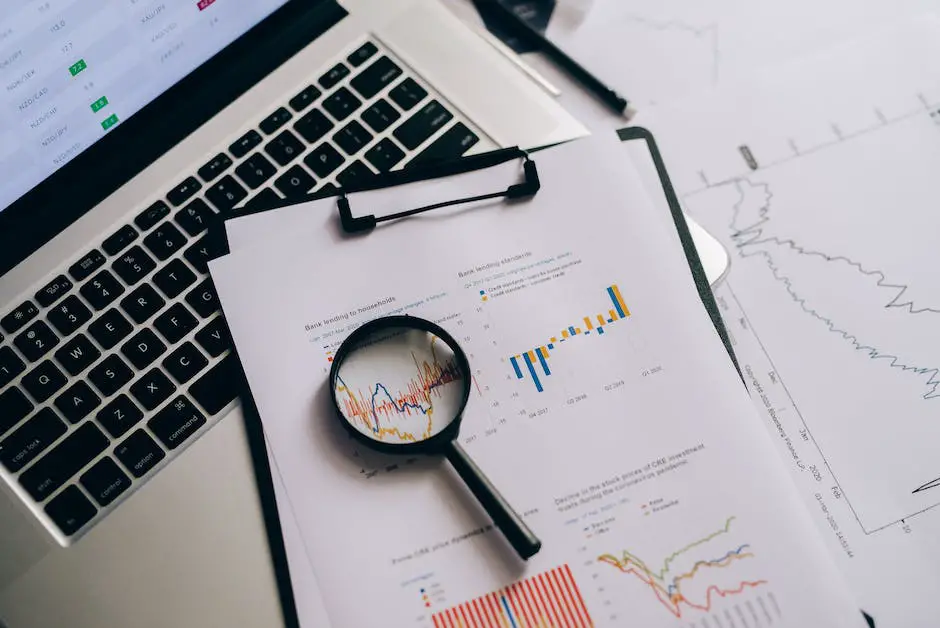
Tips to Conducting a Situational Analysis
Here are some straightforward points to remember as you make your way through your situational analysis:
- Integrate Different Perspectives: Encourage discussions and gather viewpoints from all departments, from accountants to designers. This ensures a well-rounded analysis.
- Use Reliable Data: Factual accuracy should be your golden rule. Use reliable data and credible sources to stay clear of misleading information.
- Study Best Practices: Research successful companies in your field. Understand their strategies, assess what worked for them, and why. This helps in avoiding reinventing the wheel.
- Regular Updates: The only constant in business is ‘change.’ Regularly updating your situational analysis keeps your planning on the right path.
- Don’t shy away from the Weaknesses: Identify weaknesses and areas of improvement. These are the keys to unlock potential opportunities.

About The Author
Geoff Fripp
Related posts, value proposition.
What is a “Value Proposition”?A key aspect of a successful marketing strategy is the clear definition and communication of a sought-after value proposition. A good…
Find Out More...
What is a SWOT analysis?
Using a SWOT analysisA SWOT analysis is an analytical method used to identify and understand both the internal and external factors which have an impact…
Example SWOT for 7-Eleven
This SWOT example for 7-Eleven convenience stores is designed to help you understand and structure a SWOT analysis. It is ideal for university assignments or…
Example SWOT for 3M
This example of a SWOT analysis of 3M is designed to help you understand how to prepare an structure a SWOT for strategic input.ContentsCompany Overview…

Key Elements of a Marketing Plan Situation Analysis
- Small Business
- Advertising & Marketing
- Marketing Plans
- ')" data-event="social share" data-info="Pinterest" aria-label="Share on Pinterest">
- ')" data-event="social share" data-info="Reddit" aria-label="Share on Reddit">
- ')" data-event="social share" data-info="Flipboard" aria-label="Share on Flipboard">
Sources of Information for SWOT Analysis
What does a swot analysis do for a business, internal & external strategic plan development.
- A Situational Analysis of a Strategic Marketing Plan
- Sources for Business Strategies
The success of a marketing plan depends on strong and accurate data. Reliable information is obtained through situational analysis, which is an essential aspect of establishing your organization's operating climate. The American Marketing Association says situation analysis includes "an examination of both the internal factors (to identify strengths and weaknesses) and external factors (to identify opportunities and threats)." It is often called SWOT analysis.
Strengths include the elements that strategically position an organization to succeed. When performing situation analysis it is important to understand the market strength of the organization. Assets that should be evaluated include employees, physical infrastructure, brand reputation and operating capital. All internal assets should be evaluated.
A weakness is anything that that may impede or stagnate a successful outcome. Just as a team well-trained employees can be the biggest asset and greatest strength of an organization, a staff of unmotivated and inadequately trained or equipped workers can be a weakness. Other elements that should be considered in the review of potential weaknesses are brand reputation, physical infrastructure and financial position of the company.
Opportunities

Analysis of external variables includes an examination of opportunities -- such as those presented by emerging markets -- that may influence your marketing plan's success. One example is e-commerce marketing, which is expected to continue to create new opportunities for businesses to expand current markets or create new ones. According to the website Marketing Teacher, other opportunities include the formation of strategic alliances and the creation of new market segments. Under-served markets also should be considered opportunities.
Threats are those external variables that might derail marketing and business activities. Just as burgeoning markets may create potential for your company, if your primary revenue source is a product that is dwindling in demand, you must consider the impact on future growth and operations. If you have a niche product, it might require a narrowly focused marketing plan. Other threats may include competitors whose products could replace yours -- as the Apple iPod replaced the Sony Walkman.
- Marketing Teacher.com: SWOT Analysis
Dayton English has five years of experience in creating marketing strategies and promotional collateral for non-profit organizations. He has a Bachelor’s Degree in Nonprofit Studies from Mount Royal University and a Masters in Professional Communication from Royal Roads University. He contributes to crowdfundingguide.com, a go-to resource on the burgeoning world of crowdfunding and is Principal and co-founder of marketing consulting firm Go Wired Communications.
Related Articles
What is the centerpiece of the marketing environment analysis framework, characteristics of organizational analysis, how to do a swot analysis, is a swot analysis an effective method to formulate new business strategies, explanation of swot, examples of swot, what is swot analysis in strategic goals, why is an internal analysis important, swot analysis for hair salons, most popular.
- 1 What Is the Centerpiece of the Marketing Environment Analysis Framework?
- 2 Characteristics of Organizational Analysis
- 3 How to Do a SWOT Analysis
- 4 Is a SWOT Analysis an Effective Method to Formulate New Business Strategies?

Situation Analysis

A full understanding of the reasons why businesses perform the way they do can help you identify opportunities that you can take to ensure the continuous growth, improvement, and development of your company. You may also see statement analysis examples.
[bb_toc content=”][/bb_toc]
If you are aware of the current condition of the business, then you can come up with action plans that will allow you to support the mission and objectives of the company while ensuring that all stakeholders are working toward a common goal that can help the vision of the organization to be realized. In comparison to SWOT analysis of college examples , situation analysis documents that are used by businesses provide a wider usage scope and range of process implementation.
A list of situation analysis examples in PDF is available for you to download and browse through from this post. We recommend you use these examples as references as they can help you a lot if you want to develop a comprehensive document that is also visually appealing, detailed, and well-formatted.
12+ Situation Analysis Examples
Situation analysis template.
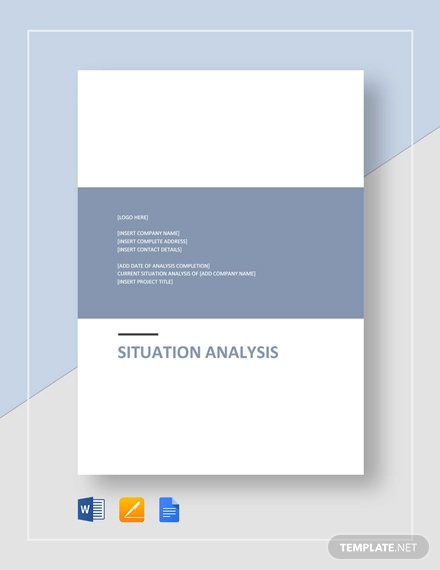
- Google Docs
Size: A4, US
Marketing Situation Analysis
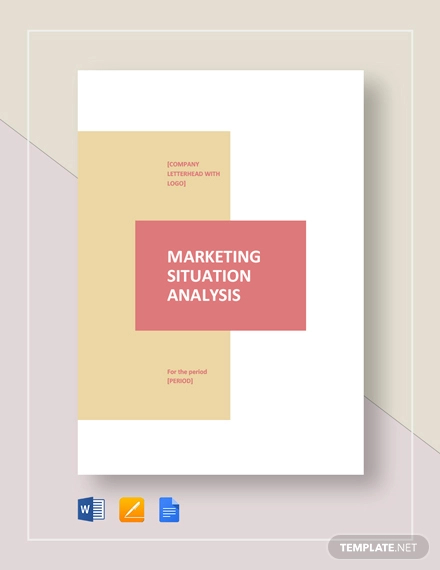
Current Situation Analysis Template
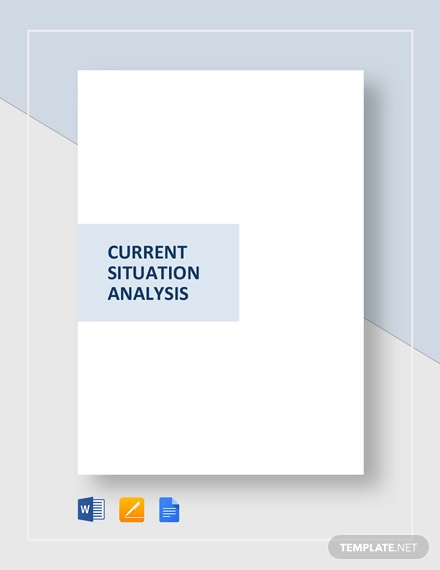
Sample Marketing Situation Analysis Template
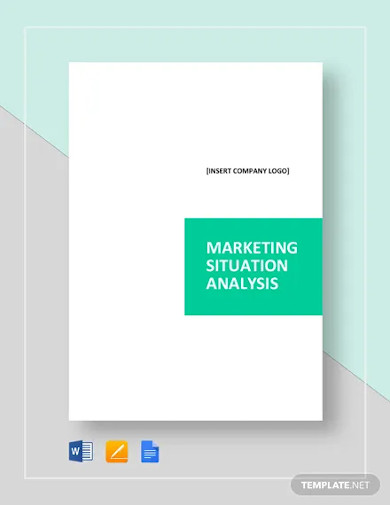
Situation Analysis Format and Components Example
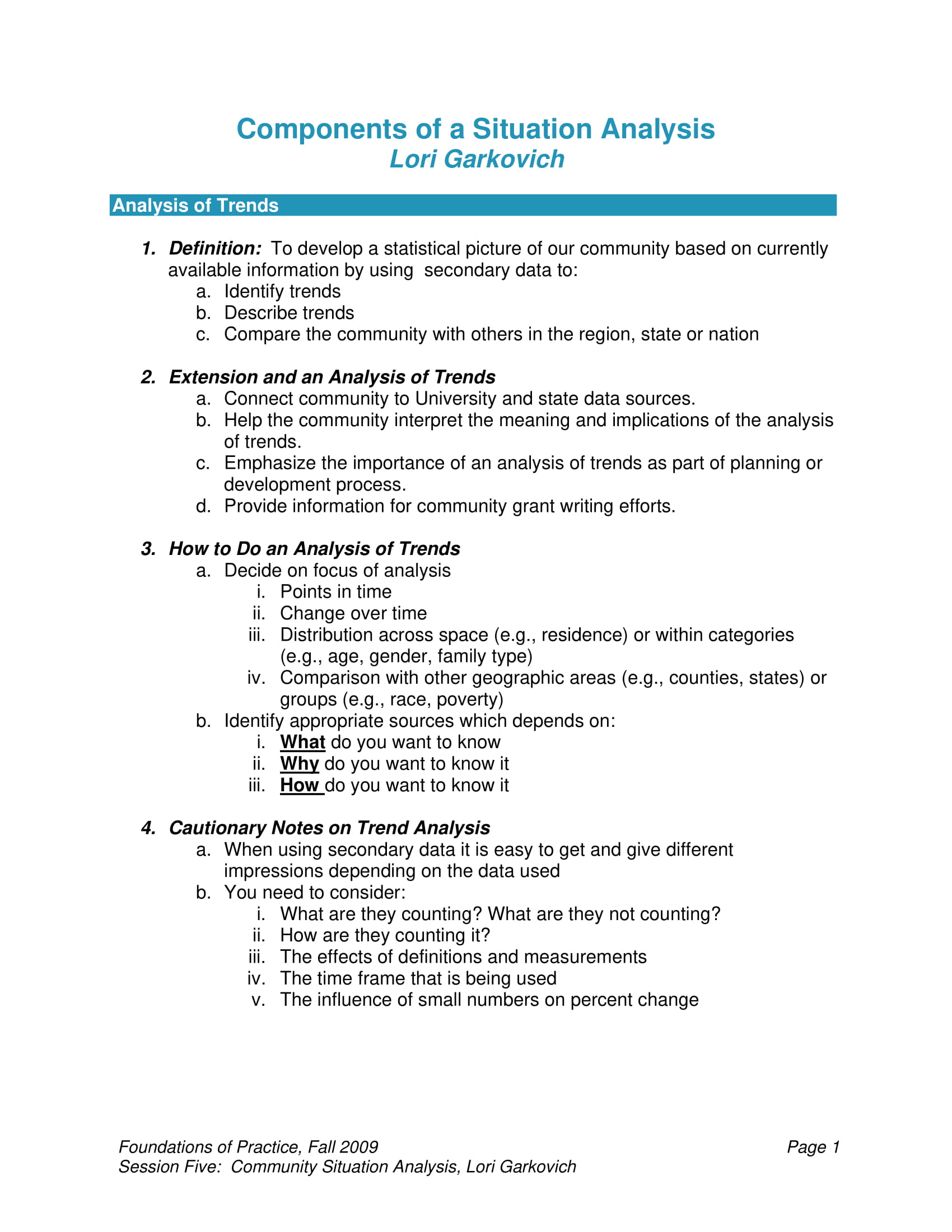
Size: 83 KB
Situation Analysis of the Health Sector Example
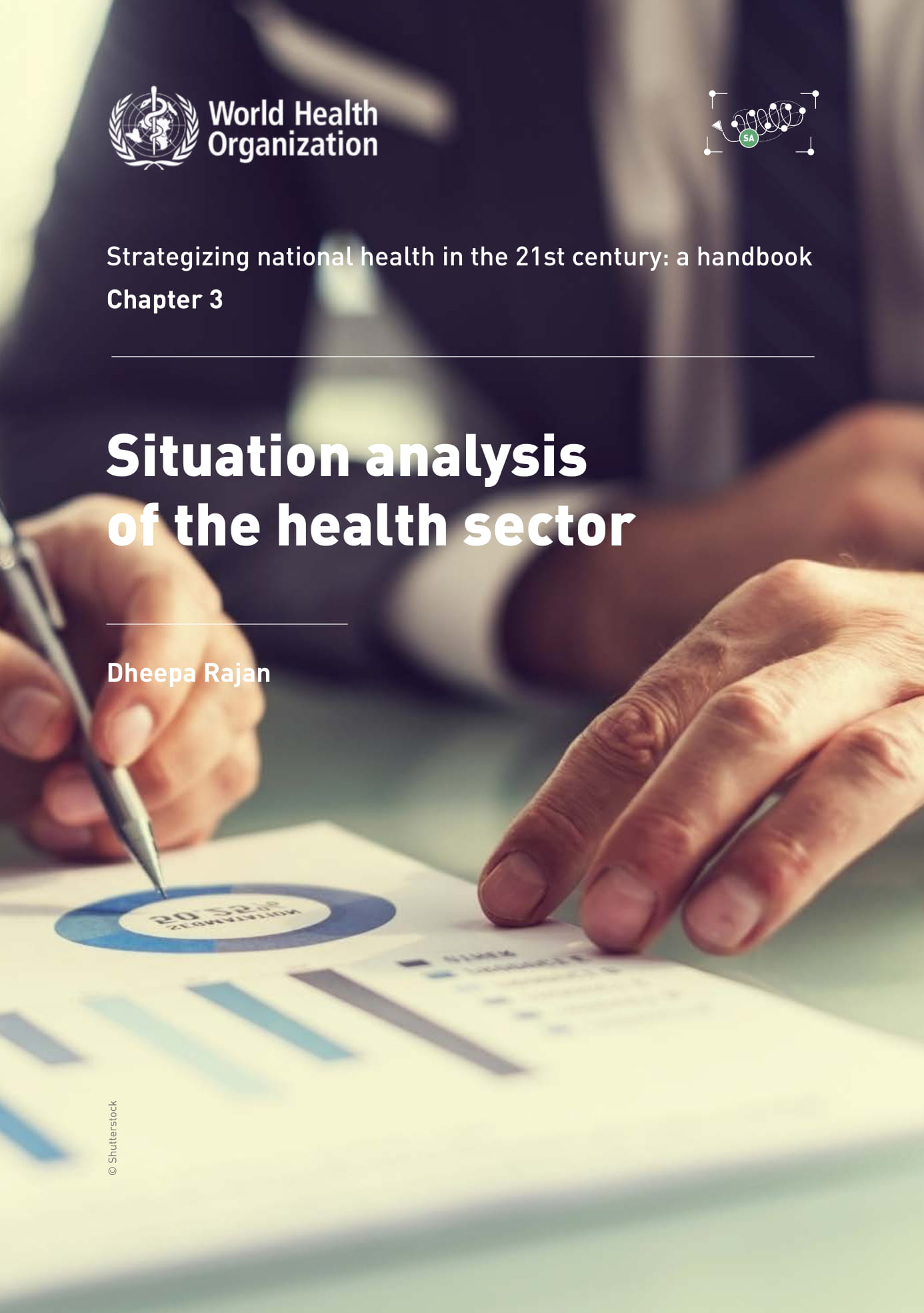
Situation Analysis Report Example

Situation Situational Analysis Example
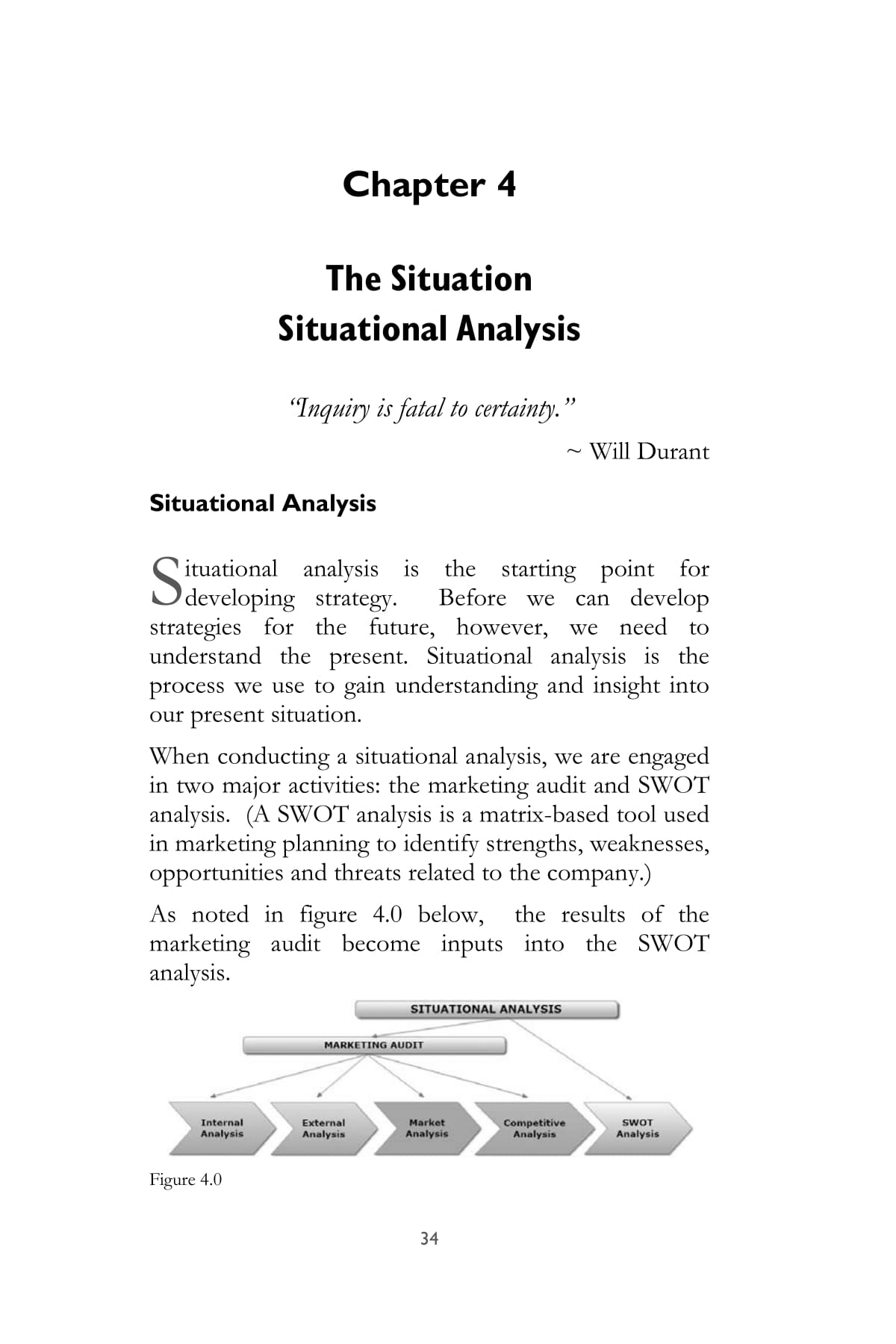
Size: 251 KB
Comprehensive Situation Analysis Example
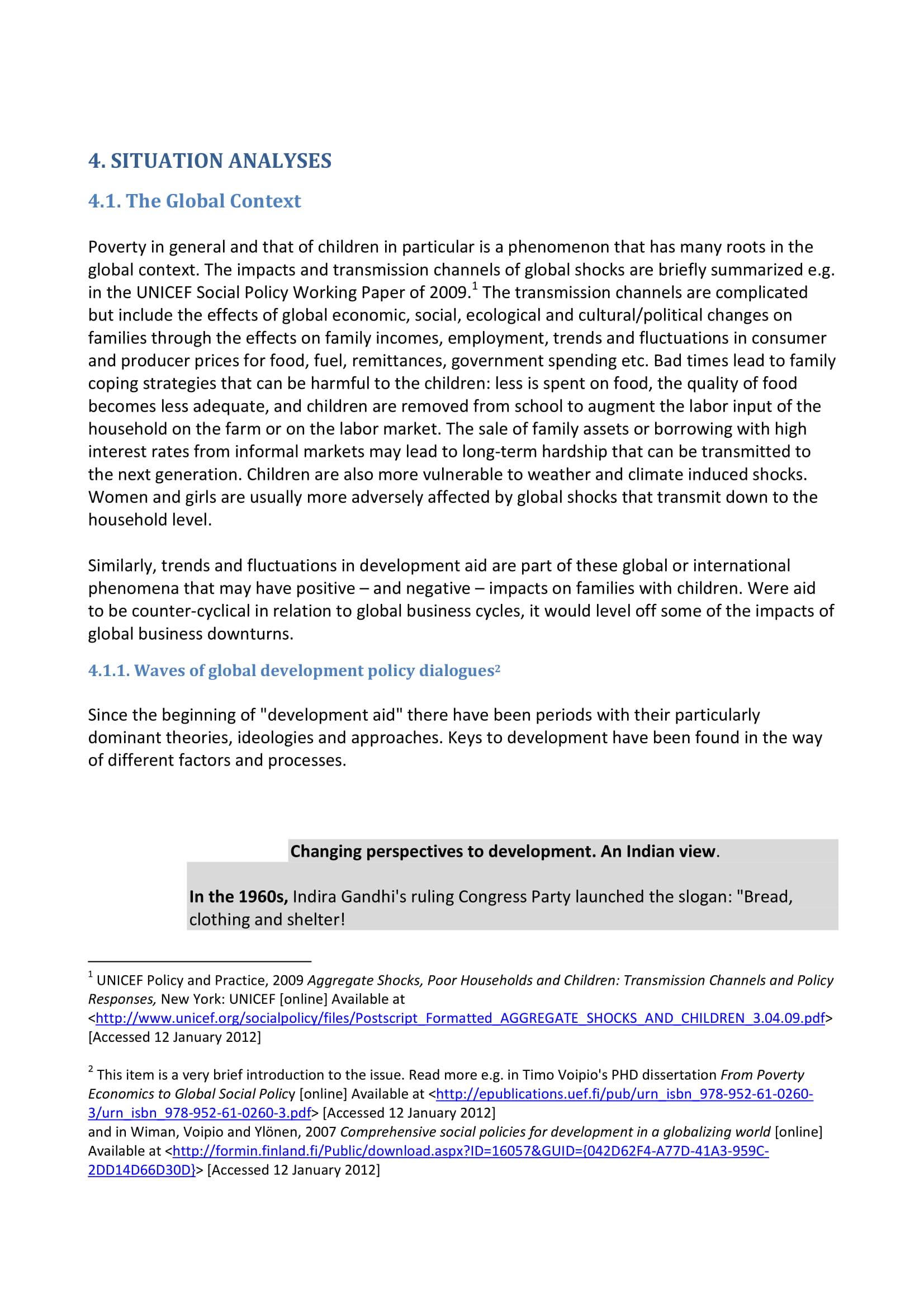
Population Situation Analysis Example
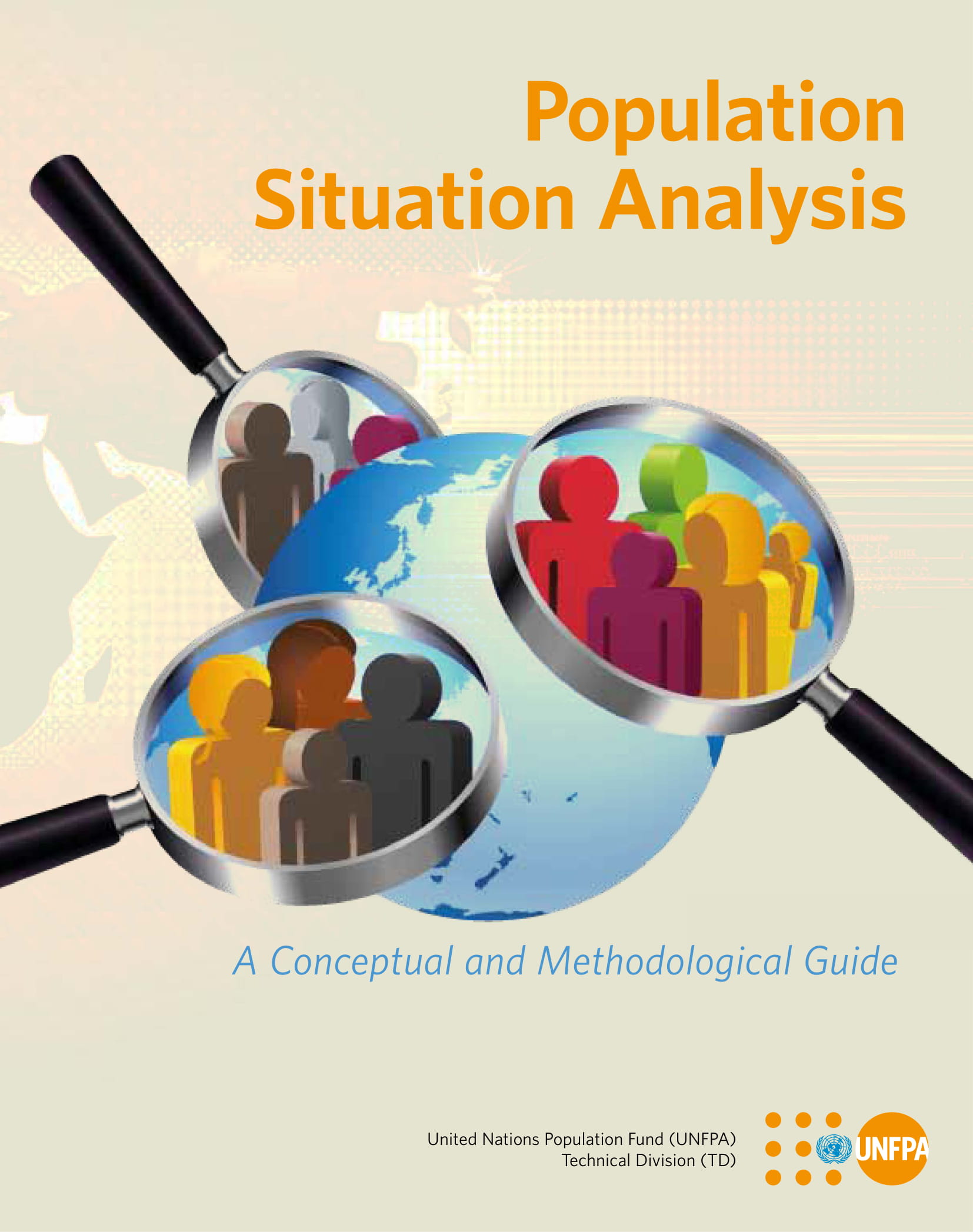
Size: 1,001 KB
Situation Analysis: Approach and Method for Analyzing Context of Projects and Programme
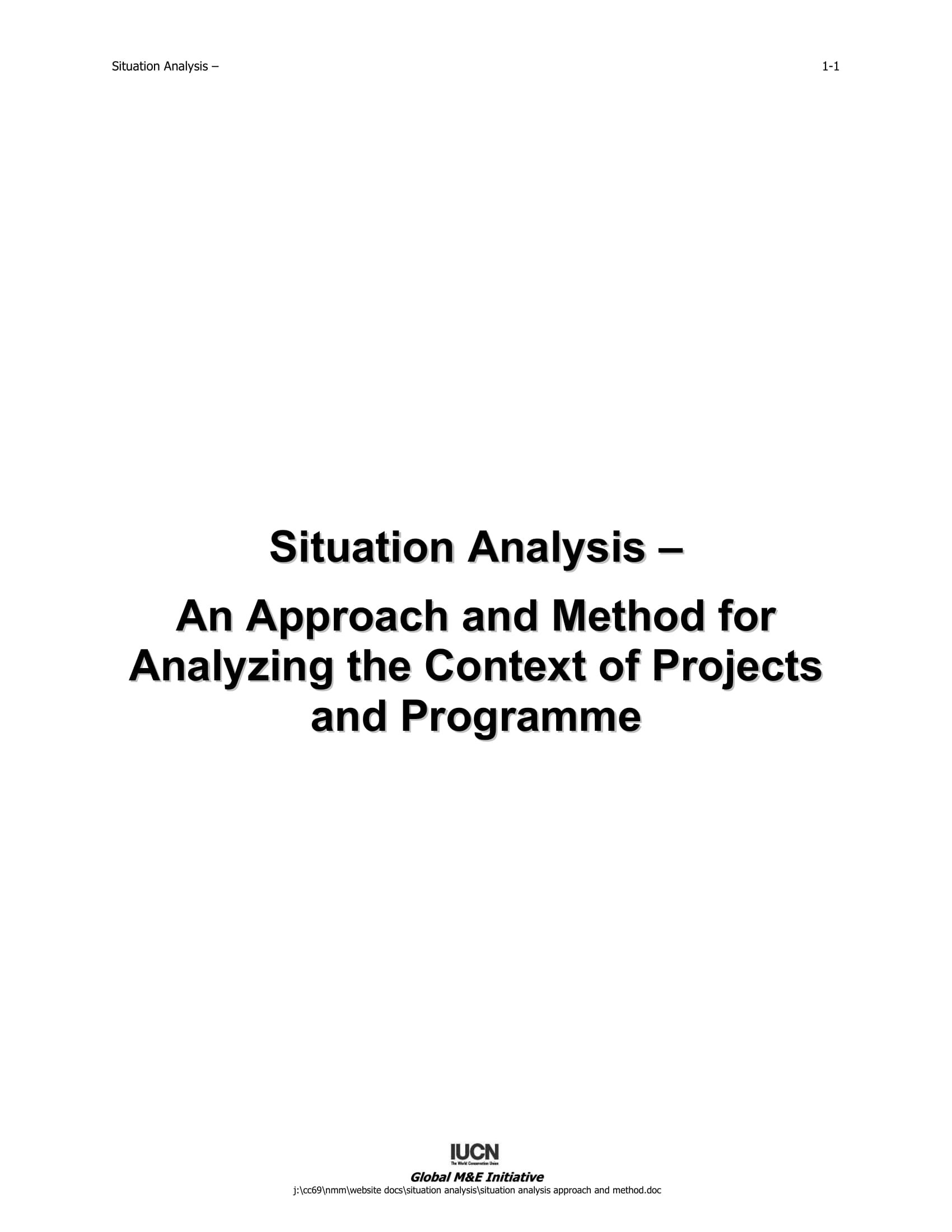
Size: 387 KB
Situation Analysis Assessing Family Planning and Reproductive Health Services
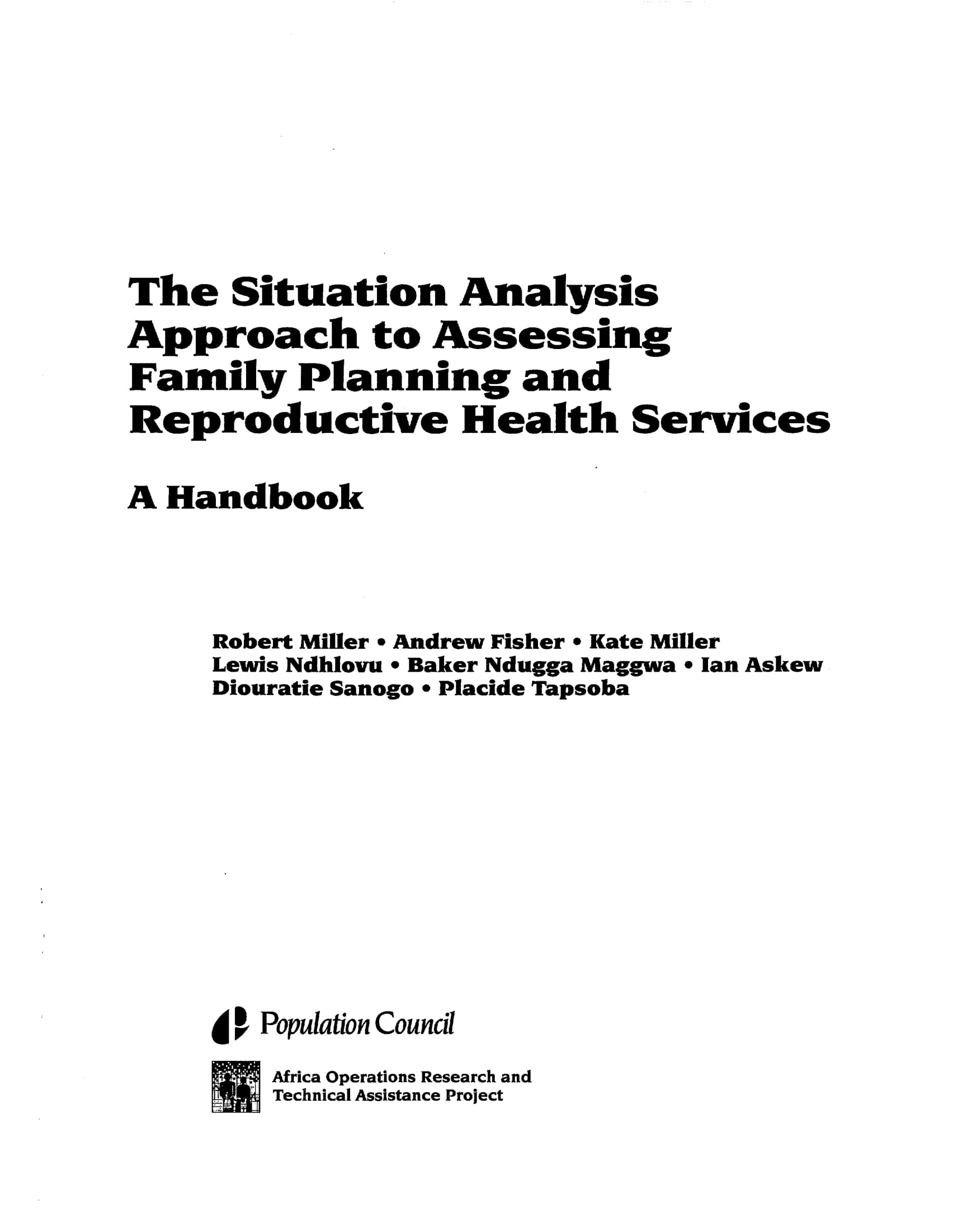
Detailed Situation Analysis Example
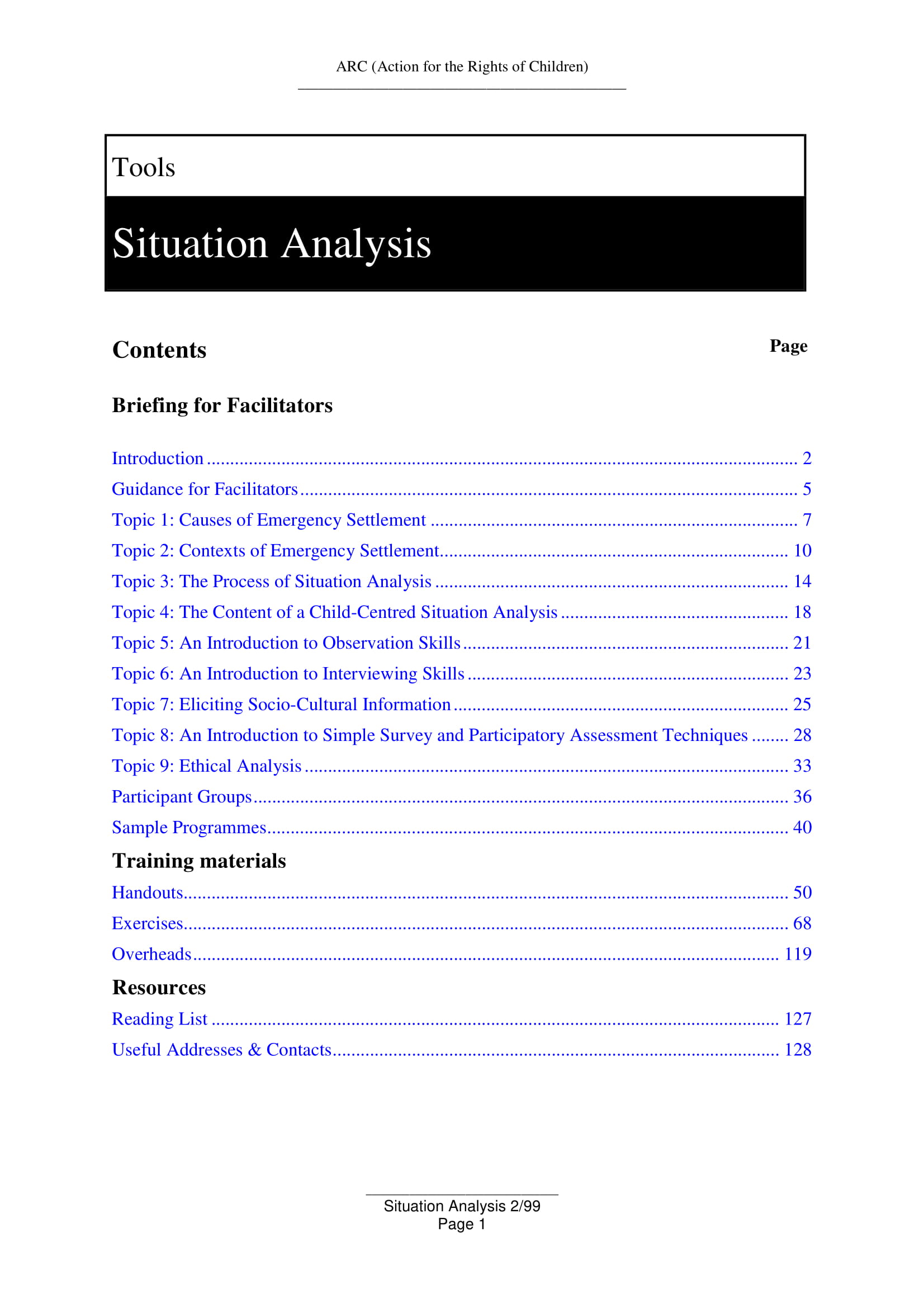
Size: 383 KB
Complete Situation Analysis Example
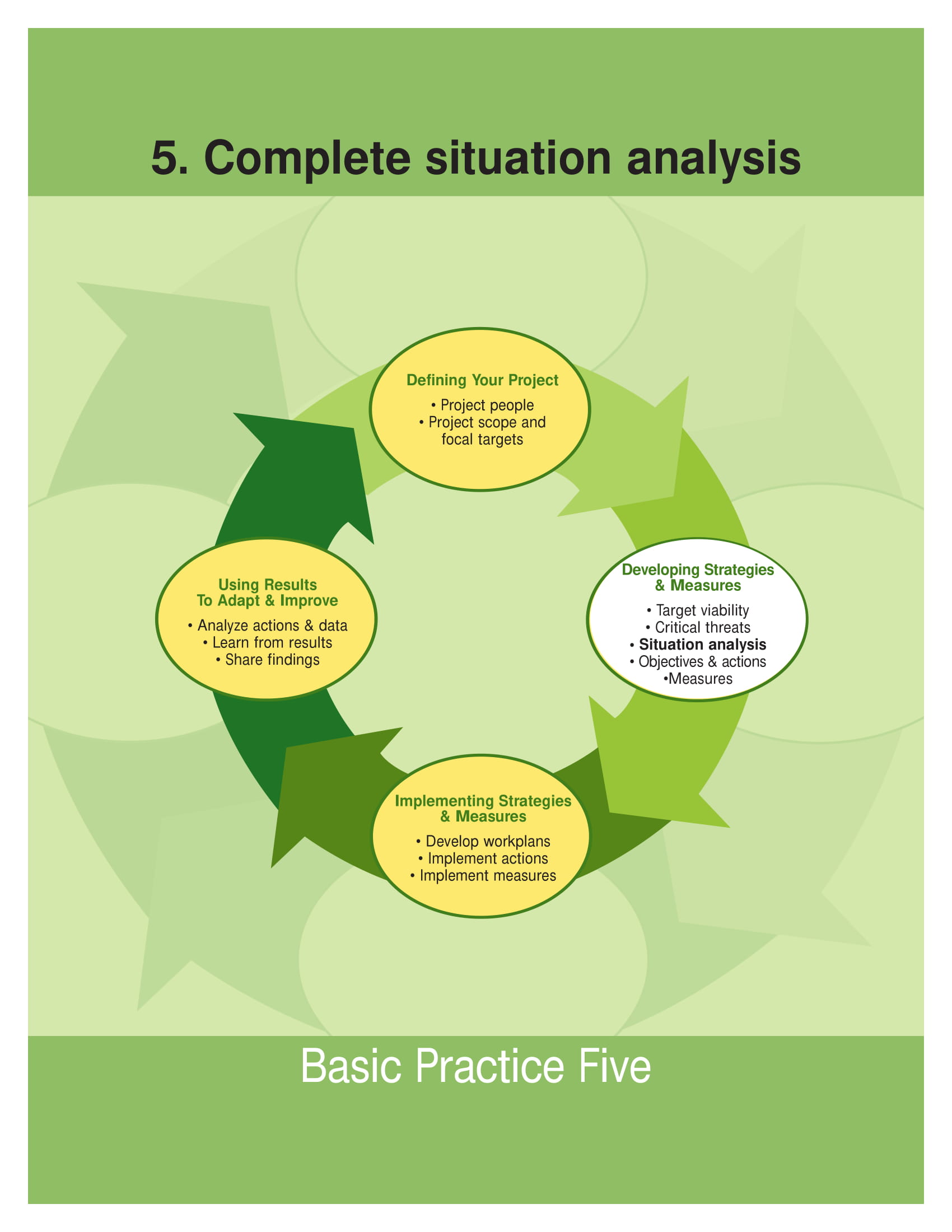
What Is a Situation Analysis?
A situation analysis does not only focus on financial health analysis or the identification of the current condition of the profitability of the business. This document is also used to provide details about all the areas of the business operations and how these areas are interlinked to ensure the smooth flow of business operations daily.
You need to have an idea of what a situation analysis is all about so you can use this document in the best and most effective way possible. Here are some of the items that can make you more familiar with a situation analysis and the ways on how you can use it for the improvement of your business and its operations:
1. A situation analysis deals with the customers of the business and the other stakeholders that impact the profitability, efficiency, and sustainability of the business. A big chunk of the current condition of the business is based on the relationship of the company with a variety of entities. These corporate and professional relationships impact purchasing decisions, partnership continuation, and process maintenance. You may also see customer analysis examples .
Having an impressive situation analysis will allow you to think of activities and programs that can maintain or even improve the way you communicate with your stakeholders.
2. A situation analysis is used by the management to ensure that they will have a reference about the existing capabilities of the organization and how these, alongside other resources, are used to their maximum potentials to help the business get and achieve its goals and objectives . The business needs to know what it is working with so that it can allocate resources accordingly for the betterment of its operations and other areas of the business.
3. A situation analysis does not only focus on what can be seen on the surface. It is a thorough discussion that can provide the core of the business operations, the factors that can result in the growth of the business, and the current hindrances and roadblocks that disable the business from getting to the state where it aspires to be at. You may also like company analysis examples .
The beauty of having a situation analysis is that it does not only highlight the strengths of the business.
As a corporate document, it is very transparent in terms of listing down all the negative or weak areas of the company as well as the strategies and tactics that do not provide that much benefits or advantages to the organization. Through this, the business can identify ways on how they can redirect the operations for the common good of the company and its stakeholders. You may also check out sales analysis examples .
4. A situation analysis is composed of different methods that allow every organization to identify all the details that they would like to know about their current situation. Most, if not all, situation analysis provides an in-depth specification of the business’s strengths and weaknesses as well as the opportunities and threats that it needs to look into. You might be interested in market analysis examples .
Having a SWOT analysis within a situation analysis is very important as this part of the document presents an overview of the internal and external business environment. If you can effectively develop this document, the business can give focus on the current condition of its internal environment while also considering external factors that can affect the operations of the company.
Advantages of Creating and Using an Outstanding Situation Analysis
A situation analysis is just like an internal audit SWOT analysis in a way that it also evaluates the strengths of the business and how they are used, the weaknesses that it needs to improve on, the threats that the organization should prepare for, and the opportunities that the company can get or grab in a timely manner. Some of the advantages that you can get and experience if you will develop a situation analysis that is highly functional include the following:
1. Making a situation analysis will allow your business to create a relevant business and marketing plan . Aside from the organizational condition of the business, a situation analysis also presents the positioning of the company and its products in the marketplace.
The way that the organization is perceived by the market is very important as it can impact the successes of the company’s action plans , or the lack thereof. If you can create a thorough and complete situation analysis, you can have a view of how the sales of the business are going and whether it is still good for the business and its current and future operations.
2. Creating a situation analysis helps promote open communication to the entities who are involved in the business operations.
Having a situation analysis document can make it more efficient for the business to list down all the benefits that each stakeholder can get from the current condition of the business operations and management. This can help establish a longer and stronger relationship between the business and its suppliers, customers, and partners. You may also see industry analysis examples .
More so, the insights and commentaries of every stakeholder can be more appreciated and used as these will be recorded and analyzed for realistic trends and circumstances related to the business condition to be identified.
3. Using a situation analysis can help the business become more prepared for unforeseen circumstances or any instances that can provide a negative impact on the operations, branding, financial standing, and condition of the business. You may also like literary analysis examples .
With the help of a situation analysis, companies can be keener in terms of developing counteractions, contingency plans , and strategies for improvement. The current condition of the business within its environment as specified in the analysis can greatly affect the view of the management when it comes to maintaining its productivity, effectiveness, and overall corporate efficiency. You may also check out needs analysis examples .
4. Developing a situation analysis can help organizations measure their relevance. Through the usage of this document, they can be aware if they are still providing the needs and demands of their target audience or whether they are still meeting the expectations set by their stakeholders. You might be interested in operational analysis examples .
Keep in mind that a situation analysis, though focused on the condition of the business, also deals with how the business performs in the marketplace. If you will create a situation analysis, you can ensure that you can monitor the changes in the market performance of the business within varying periods. You may also see requirements analysis examples .
What Do You Need to Analyze?
If you can develop a transparent situation analysis, you can proceed to the creation of a gap analysis . Know the gap between the current condition of your business based on your situation analysis and the business operations and management state that you are envisioning for your company.
For you to be able to execute this, you have to ensure that you will cover all the elements and factors that are essential to be included in your situation analysis. The most important elements that you must look into when developing a situation analysis are as follows:
1. Know the company, its nature of operations, and the core of its existence. You have to be aware of the objectives and professional goals that it would like to achieve as well as the strategies and tactics that it incorporates in its work operations to achieve its vision. You have to know the current capabilities of the business as well as the resources that it can use when it comes to improving its condition.
2. List down all the competitors of the business. The situation of the organization does not only depend on internal factors and elements.
The external environment, which includes competitions and market trends, can also impact the performance of the business within a given period. Knowing your competitors and identifying their activities and efforts can help you assess how they get their market share, how they influence the purchasing decisions of customers, and how they convert sales leads to actual business sales . You may also see organizational analysis examples .
3. Identify your target audience as well as their demands, income level, purchasing capabilities, purchasing frequencies, wants, and needs. There are different information that you have to gather about your market so that you can easily execute activities that can get their attention whenever needed. You may also like financial analysis examples .
Specifically point out your market segment, the size of your market, and the niche markets that you would like to cater to.
More so, be aware of demographic and geographic factors that can affect the successes of your general action plans . It is also important for you to list down all the factors that motivate your audience to buy your offers as well as the effective ways on how you can advertise to them. This will help you identify the time that it will take for you to reach a wider audience and for you to grow your market.
4. Specify all your distribution channels as well as your collaborators. You need to align these elements for you to ensure that you will highly benefit from using the results of your situation analysis.
Know your suppliers, partners, distributors, and other stakeholders so that you can also open touchpoints that will help them provide their deliverables for your business in consideration of the timeliness of your simple action plan execution.
Useful References for Situation Analysis Development
A situation analysis can impact not only the current condition of your business but also the future operations of your company. Having references at your disposal can help you create an outstanding situation analysis. This is similar when you plan to develop a marketing SWOT analysis or any other kinds and types of business documents .
References like templates and examples can help you become more observant of how you will present your discussion and how you will layout the final document that your target audience can browse through. Also, these materials can give you an idea of what will work and what may not on the specific document that you need. You may also see what is analysis ?
Have you already decided to develop a situation analysis? Ensure that you have sufficient references before drafting the specified document. Start by using our downloadable examples and resort with the guidance that situation analysis templates can provide you with so that there will be organization and efficiency when it comes to the development of your situation analysis.
General FAQs
1. what is a situation analysis.
A situation analysis is a method that involves a critical evaluation of the factors affecting the internal and external environment of an organization. It is done to understand the organization’s capabilities, customers, and business environment so that moving forward, the organization can devise strategies accordingly.
2. How Can You Conduct Situation Analysis?
You can conduct situation analysis by following these points:
- Conduct a customer analysis
- Review the product and distribution situation
- Analyze the competitive advantage
- Examine your environment.
3. Why is Situation Analysis Important?
Situation analysis is important for the following reasons:
- It defines the nature and scope of a problem
- It identifies strategies to overcome a problem
- It helps understand the opinions of stakeholders
- It helps detect the gaps between the current state and desired state.
4. What are the Tools Used For Situation Analysis?
Following are some of the common tools that are used for situation analysis:
- SWOT Analysis (Strengths, Weaknesses, Opportunities, and Threats)
- PEST Analysis ( Political, Economic, Social, and Technological)
- 5C’s Analysis ( Company, Competitors, Customers, Collaborators, and Climate)
- Porter’s Five Forces Industry Analysis.
5. How Can You Decide If Your Situation Analysis Is Helpful?
You can decide if a situation analysis is helpful with the following points:
- It should be simple and practical to use
- It should be easy to understand
- It should focus on factors impacting your business, both internally and externally
- It should give rise to further analysis.
AI Generator
Text prompt
- Instructive
- Professional
10 Examples of Public speaking
20 Examples of Gas lighting
We use cookies to enhance our website for you. Proceed if you agree to this policy or learn more about it.
- Essay Database >
- Essay Examples >
- Essays Topics >
- Essay on Products
Situation Analysis Business Plan Example
Type of paper: Business Plan
Topic: Products , Customers , Market , Services papers , Marketing , Business , Strategy , Gift
Words: 2500
Published: 02/02/2020
ORDER PAPER LIKE THIS
Executive summary
This report is a full marketing plan of a new business venture with the legal business name, ‘Gift Wrapping Bus’ to be launched here in United Arab Emirates. The plan provides the situational analysis, marketing strategy, controls, and financial, budgets, and forecast. It explains the product overview, competitive analysis, suppliers, inventor, research and development. So far, this nature of product and service is a new concept in the country. This is because it is the first time that it should be introduced UAE after it became a hit in Western countries and in Japan. The report also details the industry, competition and market. It defines the market of the business, compare and analyse its primary competitors, the market size, market growth, customer profile and location of the business and its competitors. The report covers the marketing plan that would explain comprehensively the competitive advantage of the business, the pricing of the products and services, distribution channels, promotional plan and feedback system.
The business is entering its first year of operation. A comprehensive strategy for marketing is paramount for the success of the business. Gift Wrapping Bus is a kind of business venture that offers customers both products and services. It seeks to provide customers with all kinds of gift wraps and packaging materials while at the same time also offer gift wrapping services. The company will be able to provide the services through the help of a gift wrapping bus that travel to the heart and outskirts of Abu Dhabi to give services for customers who call the store for their personal gift wrapping. The bus will be used for delivering gift wrapping items and providing the wrapping services through skilled wrapping staff. The company will target high profile clients who hold events and parties where people are issue gifts. For instance, wedding ceremonies, birthday parties, festive season, and some corporate events will be the primary targets for the company.
Nature of the product and service
The gift wrapping and packaging is not a new business in the market of United Arab Emirates but because of the advancement of technology, people’s lifestyles change and lives become sedentary. People want to maximize the utilization of technology to experience the utmost comforts and convenience of life. Today, we are living in a ‘push-button’ type of life where everything is run by push buttons. People just stay at the confines of their homes while their needs are delivered right at their doorsteps. The gift wrapping business will be competitive because of the ‘gift wrapping bus advantage. It would be competitive because the customers will be transported from their homes to the store back and forth or their items will be personally wrapped according to their special instructions from their homes with the well-trained artists of the stores. The mini-bus will be full of all kinds of wraps and packaging materials for the widest selection of customers. Another unique proposition of the business is the fact that the bus itself is gift wrapped as a promotional strategy. Mini-bus will be coloured in pink to identify and promote the gift wrapping business. This idea will enhance the promotional and marketing strategy because once it gets popular, people will just wait for the gift wrapping bus to pass on their area and ask for the gift wrapping services or let their items be brought to the store. It will have the definite timing of passing a certain area or location within Abu Dhabi and its outskirts. An analysis of comparison of the product and services of the competitors, ‘Gift Wrapping Bus’ will be very competitive and advantageous because the business sells two things: convenience and time. In fact, there are now many gift bags that can easily pass for gift wrapping but personalized gift wrapping adds significance to the idea of gift giving. To receive a gift wrapped beautifully brings a lot of meanings and genuine love and concern to the receiver of gift. A gift wrapped with special wrapping paper or material symbolizes how much you care for the person who will be the recipient of your gift. Furthermore, it would be something different if the artists visit your house and wrap any items you wish because you can give them special instructions. Also, visiting you home is a necessity especially if the items to be wrapped are huge and heavy like wooden boxes, figurines, porcelain plates and vases.
Market summary
The company has analyzed its target market and knows details about the customers. The information is key to planning and communication with the target market.
Market Definition, Potential and Demand
This section defines the market and highlights of its potential and demand. Market demographics The profile of the target market consists of the following Geographic The immediate geographical location is Abu Dhabi, the capital of UAE. Almost 30 per cent of the population lives in Abu Dhabi, the UAE capital. There are 4 to 5 million people more or less living in Abu Dhabi alone. Since lifestyle in the city is modern and the population income is at the average level, customers to the business are expected to be high. People want always to stay at their homes while provision of needs is done mostly on online shopping because of the advancement of technology. To save time and make it more productive, they would rather pay for the services of gift wrapping than doing it themselves. They would rather let the gift wrappers do the services at home so that they can personally supervise the gift wrapping according to their needs and likes.
Demographics
The 2010 National Bureau of Statistics (UAE) reported that the population of the country is 8,190,000. The age structure is: - 0-14 years: 20.4% (male 500,928/female 478,388) - 15-64 years: 78.7% (male 2,768,030/female 1,008,404) - 65 years and over: 0.9% (male 27,601/female 15,140) - 73.9% of the population in the 15-64 age groups is non-national (2010 )
Behaviour factor
One of the assets of the country is their people having very close family ties, friendly and loving. The country considers close relationships and unification of the people as one reason why the country is progressive and developed. This asset is the reason why gift giving is famous among people especially when there are special occasions like UAE national day, Ramadan, EidF’ter, Valentines, Mother’s Day and many more occasions. Gift giving for a love one is important and is a very significant for the giver and the recipient. The act imprints lasting effect and makes relationship getting closer. In the case of gift giving, what is outside should be as important as inside. In reality, some people just do not like to wrap gifts, so they are much happy and willing to pay any services that will do favour of wrapping their gifts. Others actually do not have time and find gift wrapping as not so productive that is why they want to use their time for other tasks and concerns. In addition, most of us acknowledge that gift wrapping is an art and therefore it needs people who have the aesthetic skill to do it so that the gifts look pleasant and attractive for the recipient.
Market size
The market size is the 78% of the population within the 15-64 age bracket. From this perspective, it is expected that the market size will grow because the population of the country has been projected to increase at a rate of 3 percent. Since the country is also improving its tourism industry, the coming of tourists increases 15% each year and this will continue to the market growth of this business.
Target Market and Positioning
The following age structures are the target market of the business. - 0-14 years: 20.4% (male 500,928/female 478,388) - 15-64 years: 78.7% (male 2,768,030/female 1,008,404) - 65 years and over: 0.9% (male 27,601/female 15,140) - 73.9% of the population in the 15-64 age groups is non-national (2010 ) In addition to this target market, the business is better positioned to offer services and products to the high income earners of the city. The business has two strong competitors namely “I Care Group and Wrapt” and Westbrook, all are located in the city of Abu Dhabi, hence they are considered direct competitors of the business. Finally, the business is also better positioned compared to its competitors because it has a unique selling proposition (USP) and that is the mini-bus. The mini-bus is free of charge for the store customers. The same mini-bus brings the services to any home that calls for home gift wrapping service
Marketing strategy
The main strategy is creation of awareness and development of brand equity. The strategies will enable the business to build a strong customer base within the market and to gain an edge over its rivals. The business will embrace the niche marketing strategy because of the unique selling proposition of the product and services. In addition, since the business seeks to target a certain geographic location and demography of the population, this strategy will succeed. Certain parts of the city mentioned earlier will be the concentration area of the business especially in Al Buttain, Al Mushref and Al Moroor. The business is also targeting the potential market with ages 15-65 years old and finally the rich or the high income earners of these places targeted.
Marketing Plan Mission:
Marketing Plan Vision: With the lives of the people becoming more confines at home because of the introduction of modern technology, life becomes more comfortable and convenient. To respond to their new lifestyles, this business venture will enhance this mode of living by providing a product and services right at homes of the customers. It will also encourage the close family ties among people; gift giving activity is designed to be more exciting and significant. The business visualizes that within five years, the business will have expansion in all the seven emirates and ten years after, it will expand to the Middle East Region.
Positioning Statement:
“To offer the best way of expressing our love for our love ones, a more innovative and most comfortable way of preparing our presents to them will be provided for the first time in Abu Dhabi, UAE by the “Gift Wrapped Bus” business.
Target marketing
Create awareness - education and awareness of the people about the new product or service need to create buzz by maximizing the use of local airwaves, print and broadcast media and internet. Logo of the company and pictures/photos of the products and information about the services will be heard, read and seen in various communication channels. Therefore, the budget to that marketing campaign will be increased. The business will use innovative strategy because since gift wrapping is not new here, yet I will be introducing the new services in re-launching the product of gift wrapping. First, to make the marketing strategy successful I have to do the following: Boost consumer confidence – in the marketing campaign, I will emphasize the quality and value of the products and services. Since this strategy can possibly boost the confidence of the customers, more likely this confidence will likely to translate into more action at the cash register.
Positioning
The products and services will be available in the store in Hamdan St., Abu Dhabi and at the respective homes of the customers. It will be the gift wrapped bus that will come to the customers and or bring the customers to the store at their most convenient time. The gift wrapping bus business will have its store at Hamdan Street, Abu Dhabi because this is the busiest area and we believe that more people mean more buyers and customers. However, the garage is in Al Buttain Area because the focuses are the places of Al Musref, Al Moroor and this area. The company will have the small bus that we believe will help the business very much because we will not only offer products like souvenir items or gift items, but also gift boxes and ready-made presents. The services meanwhile will be at the Hamdan Store and at the same time the home services of gift wrapping.
Communication
Another strategy of the business marketing is to give focus on the business communication network. This area is the best to improve and achieve successful results in business especially in the marketing stage of product or service. The product or service should be communicated to the consumers to increase awareness; therefore the internal and external communications must be very effective to convey the message. The object of communication to clients is definitely the benefits they could have gotten from the products or services. The project marketer needs to have substantial knowledge on the concept of Integrated Marketing Communication or - IMC, because this will help effectively in the dialogue with the customers by inviting interaction through the coordinated efforts of content, timing and delivery of the products or services. Clarity of the message especially the benefits of the business’s product or service offered to the clients will encourage the customers to try the new business offer. Marketing mix of the product would be the examination of price, distribution, advertising and promotion and most importantly the quality of customer service that will be offered to the potential target market. The project strategies and tactics are included in the following communication tools that will be utilized and used in this project.
Competitor Analysis
The business considers only two major primary competitors which are doing similar business in the city of Abu Dhabi. They are the following: - “I Care Group and Wrapt: Address: Abu Dhabi, UAE. It is a wholesaler and retailer of skin and body care products and offer also gift wrapping services. It is a medium size company with 16-25 employees established in 2007. Its main markets are in Middle East with headquarters in Abu Dhabi, UAE. - Westbrook Trading LLC. Address: Hamdan St. Abu Dhabi, UAE. It sells soft toys, mugs, gift bags, wrapping rolls, corporate gifts, etc. They become primary competitors of the business because they are also doing business in Abu Dhabi and are servicing the gift wrappings to customers. They also sell gift wraps like the business. The market shares of the competitors presently are:
“I Care Group and Wrapt” – 35%
Westbrook Trading LLC – 28% Others (companies not mentioned) – 37% Financial analysis This sections provides an overview of the budget and financial resources needed for the business to market this product. Projected sales Product prices Cost of service
Works cited
Benne, P.D (2012), Definition of Marketing Objectives, Goals, Strategies and Tactics, Retrieved 07.10.2012 from http://suite101.com/article/definition-of-marketing-objectives-goals-strategies-and-tactics-a321854 UAE population put at 7.2 mn, (2012), Retrieved 07.10.2012 from http://www.emirates247.com/news/emirates/uae-population-put-at-7-2-mn-2012-04-03-1.451861 "United Arab Emirates" (2010) International Monetary Fund, Retrieved Oct. 07, 2012 from http://www.imf.org/external/pubs/ft/weo/2010/01/weodata/weorept.aspx

Cite this page
Share with friends using:
Removal Request

Finished papers: 816
This paper is created by writer with
ID 267093230
If you want your paper to be:
Well-researched, fact-checked, and accurate
Original, fresh, based on current data
Eloquently written and immaculately formatted
275 words = 1 page double-spaced

Get your papers done by pros!
Other Pages
Environment college essays, valdez essays, fireplace essays, strait essays, peanut essays, dagger essays, bajwa essays, left ventricle essays, transudate essays, bullying in schools essays, exciting essays, master degree essays, academic research essays, rowntree essays, long walk to freedom essays, south african society essays, sacristy essays, mickelson essays, delays essays, postnatal essays, alex rodriguez essays, margaret zdzieszynski book review examples, interview method used report examples, example of essay on professional goals, example of interview with anna davtyan essay, free course work on experimental research methods, low income youth research paper sample, england was also a trader of silver in form of coins owing to a progressively dynamic book review sample, the civil rights movement research paper sample, essay on shell livewire handout, maintaining infrastructure through a monsoon the thai struggle research paper, ovarian cancer public awareness campaign is needed essays examples, sample case study on comprehensive soap template, example of research paper on homeland security 3, free essay on how do eating addictions start and how early, nurse to nurse shift handoff report essay, example of fn6004 options financial derivatives and risks essay, research paper on ford quality improvement initiative, good essay on organizational change needed, summarize the key points of your companys strategy essay examples, free medical ethics essay sample.
Password recovery email has been sent to [email protected]
Use your new password to log in
You are not register!
By clicking Register, you agree to our Terms of Service and that you have read our Privacy Policy .
Now you can download documents directly to your device!
Check your email! An email with your password has already been sent to you! Now you can download documents directly to your device.
or Use the QR code to Save this Paper to Your Phone
The sample is NOT original!
Short on a deadline?
Don't waste time. Get help with 11% off using code - GETWOWED
No, thanks! I'm fine with missing my deadline

COMMENTS
Situational Analysis is used to assess the internal and external factors of a business. It is used to help determine a business' strengths, weaknesses, potential new customers, and any issues that may be there. The three popular methos of situational analysis are SWOT analysis, 5C's analysis, and Porters Five Forces.
A situation analysis is a detailed examination of a company's market presence based on internal and external factors. It examines a business's current and potential customers and how they respond to the company's products and services. A situation analysis also explores a firm's capabilities and how the current business climate impacts ...
Porters Five Forces Diagram for Situation Analysis (Click on the template to edit it online) 5 C Analysis. This tool helps assess the organizational environment from 5 different areas that may affect your marketing decisions.. Customers; market segments, customer requirements and demands, market size and growth, retail channel and information sources, buying process, consumer trends, etc.
Situational analysis isn't just a theoretical exercise; it has numerous practical applications across various aspects of business management. Business Strategy Development: Situational analysis forms the foundation for strategic planning by providing insights into internal strengths and weaknesses, as well as external opportunities and threats.
Situational analysis is like a magnifying glass for your business or company. It gives you the power to see beyond the surface and dive into the core of your organization's current state. It can also be compared to a GPS for decision-making, as it guides you through the intricate twists and turns of the business.
Situation analysis helps to spark discussion and new ideas among your team members. Setting business goals: Situational analysis gives organizations the insight to set achievable and beneficial objectives. Each analysis needs to have a plan for execution developed and authorized by decision-makers. Tools and techniques of situational analysis
A situation analysis gives you the insight to identify more realistic and advantageous goals. It's an unfortunate blunder for business teams to conduct analyses but then do little with the information. For every analysis, develop an implementation plan and get sign-off from major stakeholders.
Situational analysis provides a reference point for business planning by analyzing the internal and external factors that affect your business's performance. These factors could be good or bad, creating opportunities or limiting your ability to reach important goals. Read on to learn more about the describing your business's competitive ...
Situation analysis helps inform a company's decision-making process by looking at the external and internal factors impacting its overall success. Performing a situation analysis is essential to every project planning process as it helps identify a company's strengths, weaknesses, and growth opportunities. Situation analysis helps inform a ...
Situation analysis is basically a methodical look at the internal and external factors influencing your business at any given moment. These factors might include customers, competitors, the market environment, and your business's capabilities. By examining these elements of your business and its environment, you can identify strengths and ...
Situation Analysis Example and How to Write One. Inbound 281. Marketing Plan. A situation analysis plays a pivotal role in shaping a marketing plan by providing a comprehensive understanding of both internal and external factors impacting your business and its marketing endeavors. This crucial process involves assessing current market ...
The 5C Analysis is one of a family of situation analysis models for businesses. Here, we'll break down what the 5C Analysis model entails, how to perform a 5C Analysis for your own online business, and consider a real-life example. The 5C Marketing Situation Analysis Model. As the name implies, the 5C model focuses around 5 key "C's."
Basically, a situational analysis evaluates several factors in order to identify a business's strengths and weaknesses, as well as areas of growth. It can help you uncover important details about your business and the overall marketplace, including: Customer motivation and satisfaction. Your ability to capitalize on market trends.
A situational analysis involves using several different methods of critical analysis. Here are the basic steps you follow to complete a situational analysis: 1. Conduct a 5C analysis. The 5C analysis stands for company, competitors, customers, collaborators and climate. This type of analysis is beneficial for analyzing the market environment.
Governmental and legal environment are part of the PESTEL analysis discussed in the previous section. At the situational level, however, state and local regulations also need to be part of any analysis. The regulatory burden depends largely upon the type of industry and the specific nature of the business.
If you are familiar with business plans and marketing plans, then a market situation analysis is no longer new to you. Whether it is a standalone marketing plan, or a marketing plan within a larger, more encompassing business plan, expect to find a market situation analysis section in there. This is one section in a business plan that must not be ignored or taken lightly, which is why ...
Situation analysis marketing plan example Here is an example situation analysis of a marketing plan that you can use to create your own: Wood County Animal Hospital Marketing Plan Situation Analysis Company: The current goals of the Wood County Animal Hospital are to expand locations around the local area and provide veterinary services to rural areas further than 20 miles from the original ...
By Geoff Fripp /. The situation analysis section of a marketing plan is a critical component that provides an in-depth understanding of the current business environment in which a company operates. Here are the key components typically included in the situational analysis. INTERNAL ENVIRONMENT. Internal Environment Assessment: An internal ...
State. Area of Interest. Select Your Degree. | Step 1 of 2. As a marketer, you work to evaluate markets, to explore, to research segments, and to apply STP. A marketing plan is then developed that includes a situational analysis, market research, management of the marketing mix, and STP.
In strategic management, situation analysis (or situational analysis) refers to a collection of methods that managers use to analyze an organization's internal and external environment to understand the organization's capabilities, customers, and business environment. The situation analysis can include several methods of analysis such as the 5C analysis, SWOT analysis and Porter's five forces ...
Strengths include the elements that strategically position an organization to succeed. When performing situation analysis it is important to understand the market strength of the organization ...
A situation analysis is a method that involves a critical evaluation of the factors affecting the internal and external environment of an organization. It is done to understand the organization's capabilities, customers, and business environment so that moving forward, the organization can devise strategies accordingly. 2.
A business plan can span from a quick roadmap sketched on the back of a napkin to a hefty document carefully crafted to align with industry standards. Regardless of size, it should contain certain ...
Executive summary. This report is a full marketing plan of a new business venture with the legal business name, 'Gift Wrapping Bus' to be launched here in United Arab Emirates. The plan provides the situational analysis, marketing strategy, controls, and financial, budgets, and forecast. It explains the product overview, competitive ...